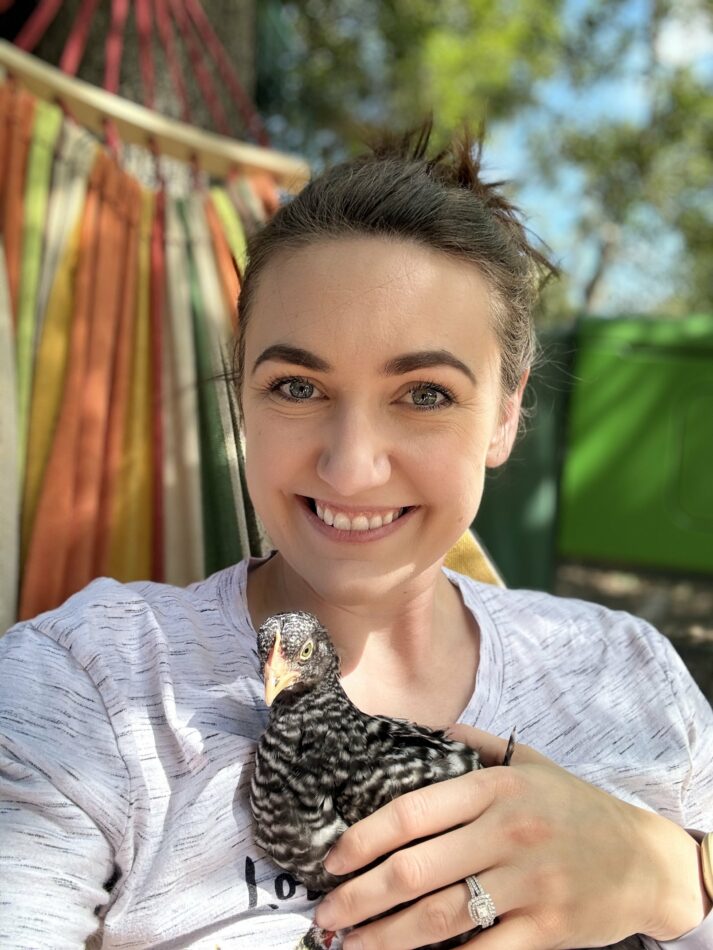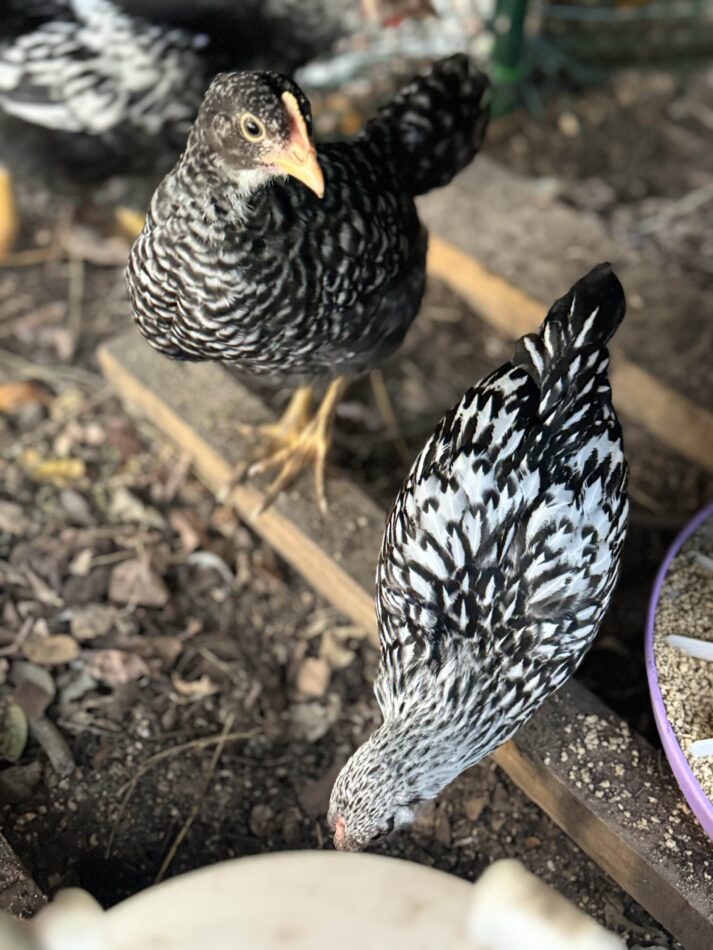What is a chicken dust bath? It sounds messy, and to an extent that’s true, but dust baths serve an important purpose in your flock. Find out exactly what a dust bath is, why dust bathing is important to your chickens, and how to make sure that your flock has access to this element of their self-care.
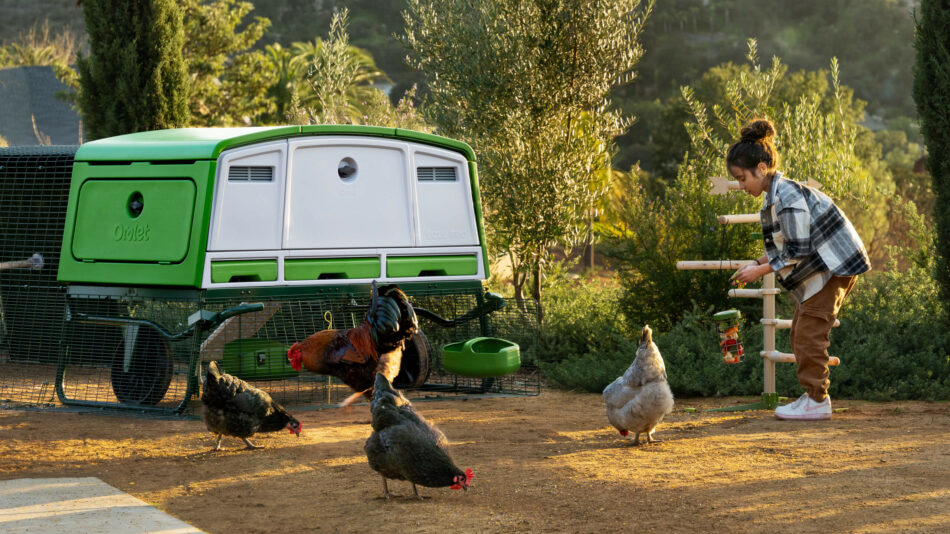
What is a chicken dust bath?
A chicken dust bath is exactly what it sounds like: a chicken bathing in the dirt. But your hens won’t be grabbing a robe and loofah — instead, they’ll plop down in the loosest earth they can find, and roll from side-to-side while tossing dirt over their bodies with their wings and feet. This strange act of bathing may seem like it’s getting your chickens dingier than they were before, but once a chicken is done with a dust bath, they’ll shake off the loose dirt and preen their feathers. Sometimes you’ll see your hens scratching around in the dirt to loosen the substrate enough to take a dust bath in, but you can also make and maintain a designated dust bathing area for your flock in their chicken run.
Why do chickens dust bathe?
Chickens don’t like being wet, so instead they dust bathe to remove parasites, insects, and impurities from their skin and feathers. Dust baths are an important part of chicken health, and also aids in keeping your flock cool during the summer. This routine “dusting off” helps keep your chickens’ feathers bright and full, and keeps their skin in good condition. It’s also a social activity that hens in particular enjoy in pairs or groups. It’s common to see best friends or sibling hens taking dust baths together if the area is large enough.
Dust baths are especially important for helping your hens through the heat of the summer and to aid your flock during their annual moulting cycle. The dirt that your hens toss onto their plumage helps to separate individual feathers from each other. In the summer, separated feathers helps circulate more air to their body to support their natural insulating system. During their moulting cycle, chickens will need to shake out loose feathers and promote new feather growth — both of which are accomplished by dust bathing.
What is the best dirt for a chicken dust bath?
If your flock free-ranges, they’ll find their favourite dust bathing spots throughout their territory. Common areas that chickens will choose to dust bathe in are:
- Garden beds with loose topsoil
- Shaded areas under trees or shrubs
- Sandboxes or other areas with loose dirt
- Ash from outdoor fire pits or burned brush piles
Chickens will happily dust bathe in any substrate that is dry and loose enough to cover their feathers. Your flock won’t want to dust bathe in areas with grass, gravel, or mulch.
You can tell where your chickens have chosen to dust bathe by the nest-shaped indentations they leave behind. Feathers are another common sighting around dust bathing areas, especially during chicken molting season. Your chickens will also choose a dust bathing area that doesn’t get saturated in the rain. If you’re making your own chicken dust bath, make sure it’s in a place protected from precipitation, and away from any chicken waterers to avoid dirt being tossed into their drinking water.
Can I make a dust bath for my chickens?
You can make a dust bath for your chickens so that they have a designated place dedicated to this self-care activity. To make a chicken dust bath, you’ll need a container or basin with high sides, such as a:
- Utility tote
- Tyre
- Kiddie pool
- Livestock feeding or watering troughs
The high sides will help keep the contents of the dust bath contained, but make sure the sides are low enough for your hens to hop in and out of. If your space allows for it, aim for the diameter of the container to be large enough to accommodate at least two hens, as many chickens enjoy dust bathing together.
You can make a quality chicken dust bath with a few simple ingredients. Choose a base, or combine multiple, then add other elements as desired.
Bases:
- Topsoil
- Coarse sand like contractor’s or multipurpose (not play sand, as it’s often chemically treated)
- Dirt or dried soil gathered from your yard
Additional ingredients:
- Diatomaceous earth (DE)
- Dried herbs
- Wood ash
- Peat moss
These ingredients fortify the dirt with natural insect-fighting components and immune-boosting nutrients to help keep your hens healthy and happy.
Omlet and your flock
Dust bathing may be a messy affair, but it’s vital to your flock’s overall wellbeing. But with an extra large chicken coop and run, your hens will have plenty of space to stretch out for a luxurious herbal dust bath. Hold the candles and glass of wine — opt for scratch grains in a chicken peck toy, or fresh vegetables in a Caddi Chicken Treat Holder near their dust bathing area for an ultra relaxing experience. Give your chickens a side of comfort and safety of Omlet along with their dirt, and they’ll be able to take the best dust baths any flock could hope for.
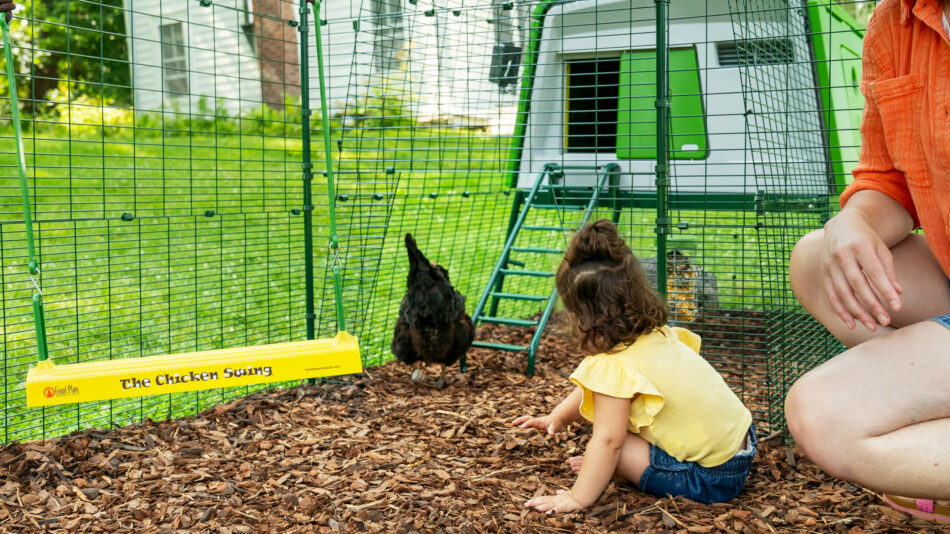

This entry was posted in Chickens
Considering an Eglu Chicken Coop for your flock? These modern feats of engineering take chicken keeping to a whole new level – especially during extreme weather. Here’s everything you need to know about Eglu coops in summer, one of the most trying seasons as a flock raiser.
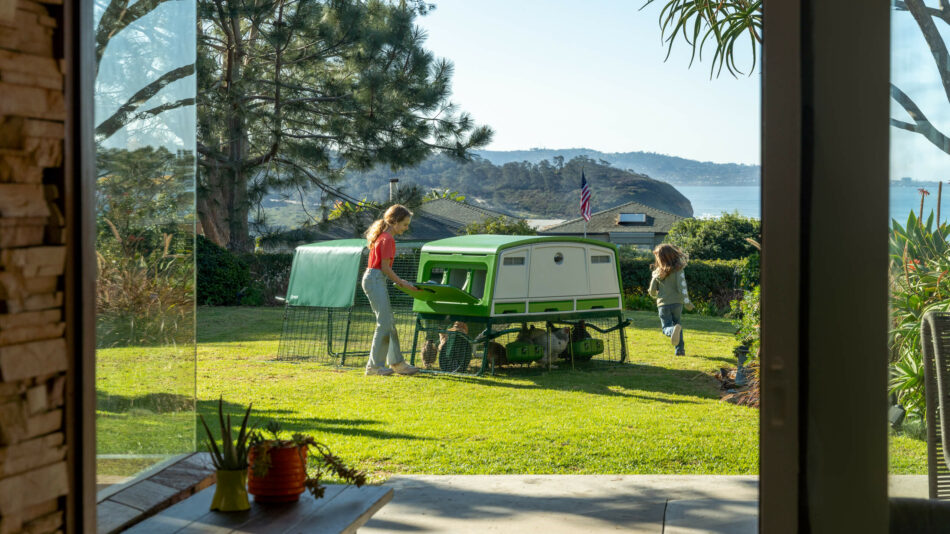
Made for all weather
All of the Eglu Chicken Coops by Omlet are engineered for extremes. With twin-wall insulation, ample ventilation, and rugged composition, Eglus are designed to withstand everything mother nature doles out. Here’s how to determine which coop is best for your flock, depending on size, chicken breeds, and your space.
Eglu Pro
Our largest chicken coop yet, the Eglu Pro can comfortably house up to 10 large breed chickens. Adjustable vents allow for more cross flow ventilation during the summer, while helping to circulate fresh air. The large interior of the Eglu Pro allows hens to spread out when roosting overnight to help keep them cool, and the elevated design allows for ample shade beneath the coop during the day.
Eglu Cube
Similar in design, the Eglu Cube is a large, elevated chicken coop. The versatile size can accommodate up to 6 large breed hens, or up to 10 bantam breeds. Shade can be found under the coop, and the droppings tray can be removed for even more ventilation during the day. The Eglu Cube can be repositioned easily with the help of optional wheels and handles, enabling you to move it to shadier spots around your yard as needed.
Eglu Go Up and Eglu Go
Both the Eglu Go Up and Eglu Go can house 3 hens comfortably. These smaller coops still feature the same twin-wall insulation as their larger counterparts, but their compact size makes them easy to maneuver. The Eglu Go in particular is perfect for broody hens needing an undisturbed place to sit on a clutch of eggs, which is a common occurrence during the warm summer months.
Summertime advantages
In addition to their insulating and ventilating properties, Eglu Chicken Coops offer additional solutions for chicken keepers trying to keep their flock cool. These features are made possible by plastic chicken coops, which outperform wooden chicken coops in every aspect. Here are some of the greatest advantages that our plastic Eglu Chicken Coops have to offer during the summer.
Parasite prevention
Red mites are a chicken keeper’s worst nightmare, and are most active during the warmer weather that summer brings. They’re hard to treat, wreak havoc on your flock, and can cost countless hours of work to fully eradicate them. Thankfully, preventing red mites in your flock is much easier than treating them. These parasites live in nooks and crannies of wooden chicken coops, but plastic chicken coops offer nowhere for these opportunistic pests to hide. With routine coop cleanings and bedding changes, Eglu Chicken Coops can prevent red mites and other parasites from pestering your flock during the summer.
Cool construction
Our Eglu Chicken Coops offer insulation to combat the warm ambient temperature. But if you live in an area that experiences intense heat and humidity, there are additional measures you can take to help bring the temperature inside of the coop down even more. For extremely hot temperatures, consider using all three of these methods:
Shade
Place your Eglu Chicken Coop in a shady area. By keeping it out of direct sunlight, the exterior of the coop will stay cooler, which will in turn lower the temperature inside. For maximum effect, keep your coop in a place that is shaded the majority of the day to help maintain its temperature.
Fan
Placing a small fan inside of your Eglu Chicken Coop can help circulate even more air through the vents. Make sure that your chickens can’t reach any of the power cords (battery operated fans are ideal), and angle the fan so that the air is blown out through the coop door. You can also position a large fan on the outside of the run facing the underside of the coop to give your flock a breeze along with their shade.
Ice
Turn an Eglu into an igloo. Frozen water bottles or plastic ice packs placed in the droppings tray or directly on the roosting rack can help lower the temperature of your Eglu Chicken Coop quickly. Your hens will appreciate the cool object to nestle up on, and the bottles can be poured into your chicken waterer once thawed.
Simple sanitation
Let’s not forget the labors of love that chicken keepers endure during the summer. It’s no small feat to clean a chicken coop in sweltering heat, but Eglu Chicken Coops make summer cleaning a breeze. Our easy to clean chicken coops can be fully sanitized in just a few minutes with the help of a pressure washer or water hose. No more scrubbing roosting bars in a stuffy wooden chicken coop, your Eglu Chicken Coop components can be removed, hosed down, dried, and reassembled before you break a sweat.
Beat the heat with accessories
Add some accessories to your Eglu Chicken Coop to assist you in your battle against the summer heat. Eglu Run Covers add more shade to your flock’s area, and a Caddi Chicken Treat Holder can hold your flock’s favorite summertime snacks. Add Chicken Perches or a Chicken Swing to your hens’ run to give them a breezy place to perch during the heat of the day. And don’t forget to make a dust bath for your chickens to help keep their feathers, which act as their natural insulation, in prime condition.
Omlet and your flock
Through thoughtful and purposeful design, our Eglu Chicken Coops bring peace of mind and comfort to flocks and their raisers all over the globe. From extra large chicken coops to small backup chicken coops, you and your hens can rest easy this summer knowing that their home is keeping them safe and cool in the heat. Add a Smart Autodoor to automate your flock’s schedule to complete the ultimate summer setup, and never worry about setting an alarm to let your chickens out in the morning. It’s time to enjoy your summer, the Omlet way.
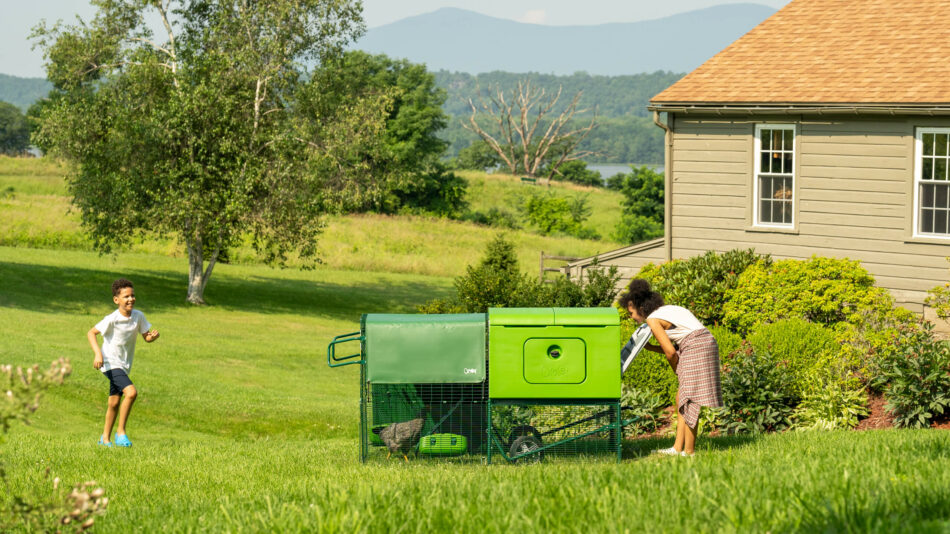

This entry was posted in Chickens
We never stop asking the questions that help us invent better. And because Omlet’s the sum of many parts, those questions are never asked in isolation, but by different people with different expertise and passions. It’s by bringing this bold thinking together that we can create truly innovative designs that bring us closer to our pets every day, such as the new Omlet Smart Autodoor.

Wonder this way
Our designs begin with conversations over coffee and ideas that go ping in the night. With the Smart Autodoor, a shift in the type of person keeping chickens has driven a change in approach to chicken keeping itself. Over to Omlet Head of Wonder, Rebecca, who leads our new product research and strategy from the front, travelling the world to meet Omlet customers and chicken enthusiasts, gathering the unique insights that help us invent new and better ways to care for chickens. She does this in the context of market trends and analysis that give her a broad understanding of what our customers need, and why.
“We’re seeing a broad swathe of millennials entering the chicken keeping market. Their lifestyles and other demands on their time make this hard – they’re often full time workers in a suburban or urban context, they often have young families – they already have lots going on and time is a scarce and precious commodity. That’s where the Smart Autodoor comes in. This is a generation that has grown up with the convenience of technology, and they want to be able to apply its potential to facilitate integrating chicken keeping into their lives.“
Rebecca Wagstaff
So, at this first stage, we will establish the demand for a product and hold it against our brand philosophies – in essence, asking, why should we design an Omlet Smart Autodoor?
“This comes back to one of our core values at Omlet, which is at the heart of our purpose: enabling more people to keep chickens. Our designs are based on the belief that more people should be able to keep and have the benefits of keeping chickens, even if they don’t have lots of land or lots of time. So we want to design products that enable them to do this, and in a really efficient way.”
Rebecca Wagstaff
This evaluation and analysis is a key part of the journey before we get into the workshop. We need to be sure that any product we design will capture the spirit of Omlet and our purpose – bringing people and pets closer.
“There is a lot of noise when it comes to technology and connection. Because there is of course some argument and concern that technology reduces connection and interaction. But when it works in the right way, to support our bonds rather than replacing them, then it actually enables you to be more connected.
And this is the purpose of the Smart Autodoor – by being able to check in with and control your coop door from your phone efficiently, via the Omlet app, you can have peace of mind even if you are not at home. You can see the status of your coop door in real time. It is about staying connected, wherever you are.”
Rebecca Wagstaff

The Omlet what?
In case you missed it, that was the Omlet app – developed alongside our Smart Autodoor to enable its potential, and opening up a new world of tech-facilitated chicken keeping. Enter Dave, Head of Technology here at Omlet HQ.
“Technology and product design are natural partners, increasingly so. Look at light bulbs, doorbells, fridges, washing machines – all these appliances can be started from your phone. So why not your chicken setups? It’s a functionality a lot of our customers want. They want to be able to connect with and control their coop when they’re not home.”
Dave Legg
Having established that the Omlet Smart Autodoor was a product our customers wanted and that would build on our brand values of chicken keeping for all and closer connections with our flock, it was time to rope in Dave and the team and get their formidable but enigmatic brains whirring.
“As a process, designing the app was fairly straightforward, as we were able to use tools similar to building our website. We did, however, have to write new firmware for the control panel itself, to enable the new functionality. Firmware is like software, but built into the hardware itself – so a bit less soft if you like.
We have kept all of the logic that makes the door work in the hardware of the door itself, which means you can still program your door settings using the control panel on your coop – and it will function just fine without needing to communicate with your phone, or with the Wi-Fi.
So we’ve kept all of the current functionality – including the control panel – but improved it by connecting it to the internet. This allows customers to check their chickens are safely shut away from wherever they are in the world. We could have removed the control panel, and built all of the smart electronics directly into the door itself, but we know that the smart functionality is not for everyone. Retaining the control panel allows the product to work for all of our customers – and it means that anyone with our current Autodoor who wants to upgrade it to a Smart Autodoor needs only replace the control panel, rather than the door itself.”
Dave Legg

The Omlet Perfection Process
Another cornerstone of Omlet design is to test, refine, and test again. We call it the Omlet Perfection Process, and no app, coop or Smart Autodoor is exempt.
“This process of test, refine, repeat is a huge hallmark of Omlet product design. And it’s really valuable working with our customers along the way – they have really enjoyed the trials – we get really high engagement, our audience is very switched on. It’s brilliant for us to get their unique experience and perspectives on what they need the product to do, it helps us go further. It is so powerful. One customer, one word, can make the difference between a good product and a great one.”
Rebecca Wagstaff
Back to Dave, who was also heavily involved in the testing process, running the program alongside Rebecca with the interdepartmental pizzazz we pride ourselves on.
“Because our process is driven heavily by testing, we’ve been able to run a lot of diagnostics and troubleshoot ahead of launch. Working with our testers in the program, we’ve been able to see details from the device, which we normally wouldn’t be able to see.
So, the doors being tested have sent data to us, like battery levels, the time it takes for the door to open and close, which has been really useful for analysing and refining. We’ve had access to a lot of data, and because it’s connected to the internet, we can do that remotely. The doors check for software updates every 24 hours, which means that within 24 hours any updates we make can be rolled out globally.”
Dave Legg
In layman’s terms, we connected to lots of Smart Autodoors out in the wild, and combined humans communicating (Rebecca) and machines communicating (Dave) to make sure everything and everyone was talking perfect sense: so, if the Omlet app tells you your Smart Autodoor is closed, then you can rest assured in the sweet knowledge that it is.
Meanwhile, in the workshop…
For an article about design, it says much about this product that we’ve yet to talk to anyone in the Design team. Time to introduce Design Manager Josh, whose role was to bring electronics and product design into the equation and transform our existing Autodoor into its new, smart incarnation.
“My responsibility was ensuring that the physical design and the electronics development were running smoothly together, and working closely with our Technology team, who were developing the app that will let you operate the Smart Autodoor from your phone.
So, we had the Technology team writing the code and our Electronics Engineer designing the PCB. The PCB is the electrical board, housed inside the control panel, which programs the Autodoor and communicates with the app. I was overseeing the design on the panel itself.”
Josh Davies
An interesting part of this project is that the physical design of the Autodoor itself has changed very little, with good reason. It stems from another central Omlet design principle: longevity. We design for life, not landfill. Our Autodoor is already smoothly running schedules in backyards around the world. We wanted to make our existing Autodoor more valuable to our customers, not necessitate its replacement.
Same, same but different
“The Autodoor was already a fantastic product, so it was important not to fix what wasn’t broken – but this was a chance to step back and look at it and see if and where improvements could be made, and the control panel was an opportunity. So we redesigned it, for aesthetics but also for functionality, based on customer feedback that we get from our customer experience team and from observations we’ve made ourselves, when using it in the design garden.
Something that comes up is the difficulty of opening the panel on cold mornings, when your fingers aren’t so deft or perhaps you’re wearing gloves. We added a little catch, so it’s easier to open. We also swapped the screws from front to rear facing, making it easier to lift them out.
But as for the door itself, we didn’t need to reinvent the wheel; our Autodoor works brilliantly.”
Josh Davies
So, this is the same tried, trusted and adored Omlet Autodoor. But with a new Smart Control Panel. And a sparkly new app. Sounds good to us.
“We’ve been designing chicken coops and inventing products to help people care for their chickens for 20 years, and our approach is to always keep building on what we know, with what we learn. So the Smart Autodoor is a new, exciting product, but it has two decades of Omlet attention to detail and design experience built into it.
Our Autodoor already stands out – and we’ve kept everything that made it unique. I think the main factor is its reliability – the testing we do here is so extensive, even down to the detail of the grease of the gears. We use a particular formula that has been specified to work in low temperatures, and tested in extreme weather conditions, so in freezing cold weather, snow, ice, rain – we know our Autodoor won’t be affected.
Sustainability is at the core of how we approach product design. Everything we invent is built to last and consciously designed with purpose and longevity in mind. So we were never inventing a new product that makes our existing Autodoor obsolete – everyone who already has an Autodoor can easily upgrade it to have the same smart functionality, just by buying the new Smart Control Panel and downloading the app. So yes, it’s the same Autodoor. Only now, it’s smart. Really smart.”
Josh Davies
So there we have it. After a lot of wondering, communicating, connecting, testing, refining, repeating, the Omlet Autodoor is reborn as the Omlet Smart Autodoor – all set to open up fresh new ways to connect with your flock.
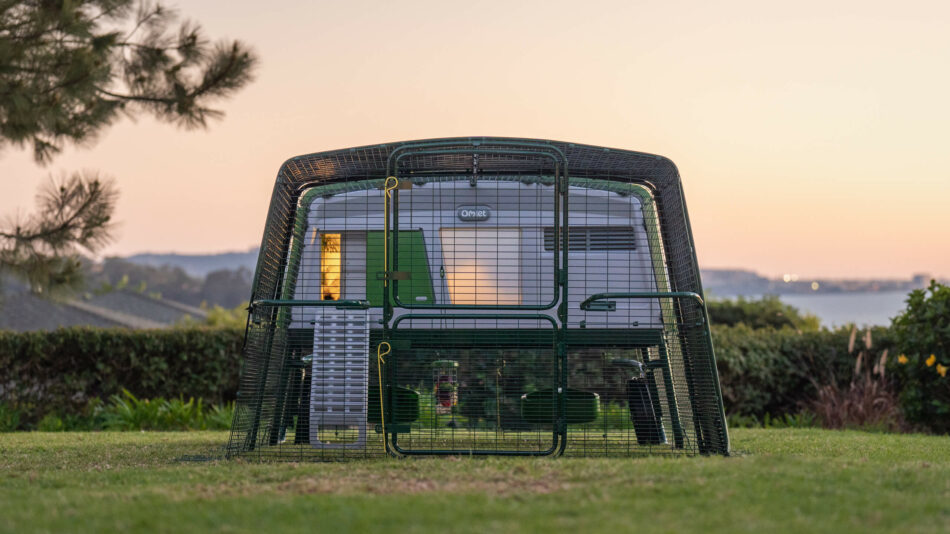

This entry was posted in Chickens
One of the pioneers of the Omlet Ambassador Program, Jeremy discovered an unexpected synergy with his professional expertise on his chicken keeping journey. A Florida based building design engineer, we first connected with Jeremy when Omlet Co Founder James was traveling around America meeting customers. James found Jeremy data logging the Eglu Cube’s internal environment. Unsurprisingly, they hit it off.

Omlet Ambassador Jeremy Gary, from Florida, USA
So, Jeremy, tell me how you first got into chicken keeping?
Well, initially, it was my wife and son who wanted to keep chickens. I grew up with a farm behind me, and to my mind it sounded like a lot of work – and I already have enough of that! But I wasn’t set against it; I agreed and we started to look at options.
You know, everything I saw was garbage, just overpriced for what it was. For starters, wood just does not do well in our environment. The humidity will claim it straight back. And I could see that these coops were flimsy: they just weren’t going to stand up to predators. But we had already got these chicks and we were racing against time.
I finally came across an image of the Eglu Cube online. I began to do the research, to look into it. Back then, there was no Ambassador Program like there is now, so I had to go on what I could see online and to me, the design just looked like it would work. So we bought it, because I thought it would work.
And it did?
Well, I’ll tell you a story. I became more involved with Omlet after Hurricane Ian. Because we were hit. My entire backyard was destroyed. There were trees everywhere, fences gone. And I came out once it had passed, and there was this coop, just sitting there in the middle of it all. So, when you talk about the cost, about the investment, that to me is a big part of it.
Of course, not every coop will have to deal with a hurricane. This thing took down 40 ft trees – it was as big as I’ve ever seen. It’s hard to communicate what that looks like and feels like. It was astonishing. So I took a picture of the wreckage with my Eglu Cube in the middle and I sent it to Omlet Customer Experience just to let them know, hey, my coop is still here, even though nothing else is!

Jeremy’s Eglu Cube still standing after Hurricane Ian hit
Is that how you became an ambassador?
Look, if someone is going to invest, it’s great to be able to come and see it for real. So that’s why I think the Ambassador Program is so important. Because you can really communicate that value. It might be hard to understand that just by looking at it online. Right now, a lot more people are keeping chickens. There was the egg shortage during Covid, among other factors. Local interest is climbing, and for a first time customer, visiting an ambassador like me can really be a link with Omlet, a tangible connection, and I think that’s important with a big purchase.
So… hang on… you’ve gone from going along with getting chickens because it was what the family wanted – to being an Omlet Ambassador?
Yep. I came into this indifferent – I was going to be a bystander. I went from “Sure, OK, whatever you want to do,” to where we are today: I’m an Omlet Ambassador, and we currently have two Eglu Cubes, a Walk In Run, now an Eglu Pro – and we’re expanding our flock. I call it the chicken campus.
Sounds like a classic case of chicken math!
We started with three, an Ameraucana and two Easter Eggers. We were very selective and got them on a local farm. It was for animal welfare of course but also the human side – the hygiene factor of raising chickens is of utmost importance. So we found a farm that we were really impressed with.
Then, we got three Rhode Island Red refugees from another keeper nearby, whose setup was destroyed by the hurricane. They’ve since got another wooden coop, and within a couple of years, it’s already falling apart. We’re actually going to give them our original Eglu Cube now we have the Eglu Pro, because we don’t need three coops, even with our new arrivals, we have plenty of space.
So, we have the new chicks coming from a hatchery in five weeks. We tried very very hard to find someone locally, but it was tough. I couldn’t find anyone this time around that I was happy with. I looked carefully and chose a hatchery with a good reputation. It sounded strange to me at first, the idea of buying chicks in the post, but now I understand it, I understand it is fine. And there was quite a demand – we had to get in line! We have a Blue Copper Maran, a Wheaten Maran, a Blue-Laced Red Wyandotte and a Buff Brahma. My wife chose – she’s the one who cares what breeds we get. For me, we just need to look at ones which are hardy. So we will have 10 when they arrive. We may go to eleven or 12, we’ll see. I felt like with the Eglu Cube, six was comfortable, but that is because our Rhode Island Reds are big.
Do they have names?
With the first three, we each named one. I named the matriarch, Chicken Nugget. Because she looked like a nugget when she first hatched. Then there’s Fluffy, our second in command, the queen of broodiness, she has like four/five/six broody cycles a year. But she’s the sweetest too. Then Lila is third in command. She is the feistiest of them all – she’s the one that keeps the separation with the newer three – who all look pretty much identical. One of them’s called Runner, for obvious reasons. And actually she’s more strawberry blond since the moult. The other two, I’d have to ask my son. Only he can tell them apart. They are very much household pets, which is another reason why I would always recommend Omlet coops, for the security they provide.
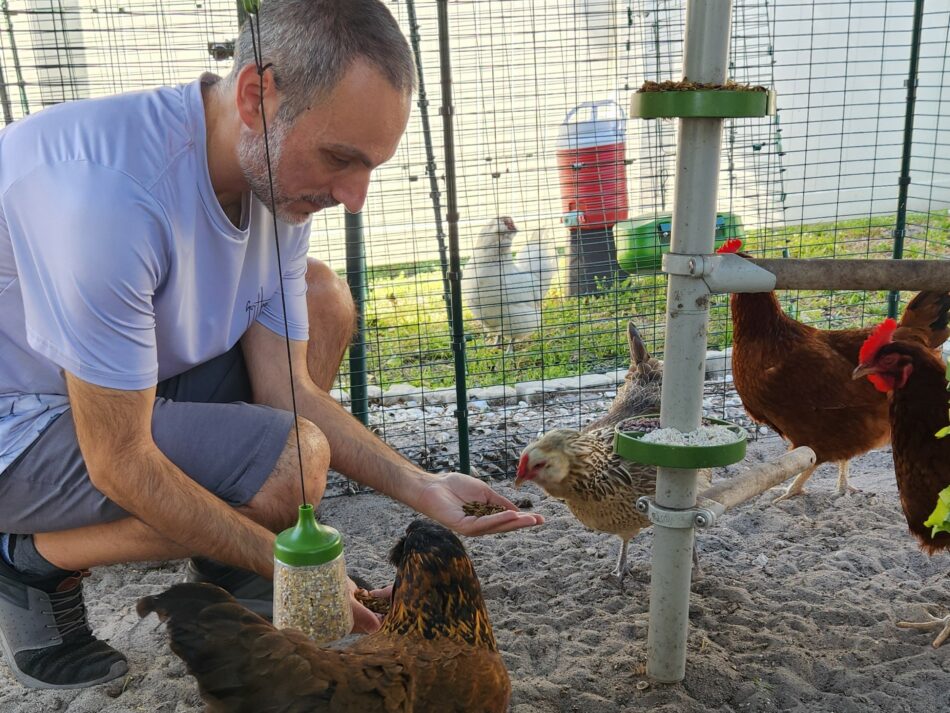
Jeremy feeding his chickens inside the Walk In Run
Yes, indeed, the predator problem…
We’ve experienced it with the Eglu Cube and now already with the Eglu Pro, we come out and we see scratch marks around where predators have tried and tried to get in the coop overnight. Here in Florida, we have racoons, coyotes, bobcats. We’re in an area right along the coast, and there are predators everywhere. Where we are is a hotspot of development. Everyone is moving here, and the effect on these predators is that it condenses them. They’re more brazen, more desperate, which makes the chickens subject to some really determined attacks.
I saw a bobcat get a rabbit when I was taking a walk one night. It moved with total silence. I didn’t know it was there until it grabbed the rabbit and then it was gone. Coyotes aren’t scared any more. The coop will be literally covered in muddy pawprints in the morning. So keeping the flock safe is a huge piece of the puzzle. Most other coops I see, well, I couldn’t see them stopping a determined raccoon.
Then you have aerial attacks, which is probably an even bigger threat. I went out one morning, and I couldn’t hear them. Not a sound, and I thought, why aren’t they making any noise? Then I saw them, and they were all standing there, completely silent. I looked up, and there were seven hawks in the tree above their run, just looking down at them. The chickens were frozen. So, yes, it would be lovely to let them roam completely free – but not for long. The predator proofing that you get with an Eglu, that is invaluable. I talk about layers of security. An Omlet coop has layers of security. Because a determined predator will keep coming back. The evidence is there that they’re trying, but they don’t succeed. They can’t defeat it – and when you consider your chickens as pets, you try to protect them as such.
Yes, it means a lot to know they’re safe.
It’s not just predators – there’s the climate too. The coop is insulated and it’s great for the elements – but you still have to pick a spot with shade. It’s important to think about the local climate, and that’s where the Ambassador Program is helpful. Florida is basically a swamp. So a wooden coop just is not going to stand up. Then, because we’re in a hurricane zone, we can’t have any fixed structures. So both the Eglu Cube and the Eglu Pro comply with that. We can move it. We don’t – but we could. Local experience with chicken keeping helps.
So these are the kind of conversations we’ll have when people come to see our setup, which might begin by talking about a product, but are more the lifestyle. For example, the unsung hero of Omlet inventions is the Autodoor. I don’t mind telling you I laughed at first – I don’t know how I got talked into buying it. Well, it’s a game changer, truly. Unless you want to be up at the crack of dawn, every day, and be there to put them away every evening, you NEED this door. And when you go away, having the Autodoor means you can ask your neighbours to watch the chickens. Because it’s no big deal. It’s extremely reliable too. So, when someone is starting out, they might think, “Oh I don’t need that, I don’t want to spend that extra money,” but actually you need to hear it from someone who knows, who has been doing this for a while.
So to go back to your earlier question – that’s why I became an ambassador I guess. I do it because I want to be the resource for people that I would have wanted, when I started out.
It sounds like it’s been quite a journey – when did it really get under your skin?
I remember, we had the first chicks and I was racing against time because it took longer than I thought it would to find the right coop, and then I was building and assembling it, and by then they were roaming around me. They just walked around me and right from the start, they endeared themselves to me, because just by being with them and being around them, you realize they each have their own personality. They’re very soothing and comforting – they’re therapeutic. I run my own business and that gives me all the stress I need. There’s something very simple and basic about keeping chickens. You go out there, you feed them, you interact, they have their personalities and their quirks.

Jeremy Gary’s chicken keeping setup
Yes, every chicken keeper says this and it’s so true – they have so much character.
We did a photoshoot after I’d finished assembling the Eglu Pro, and their personalities really came out when I was photographing them. Some really wanted the limelight, some were really intrigued by the coop. I began this journey as a bystander. Now, when we’re done talking – I’ll be heading straight out there with the bananas, the treats. I’m the chef, I’m the one who always comes out with the treats, and they know it. When they see me, they rush outside and make a real hue and cry over it. It never fails to amaze me. I bring out tons and tons of food – and they still jostle and bicker like it’s the last scraps on earth. They’ve all got something to say! They’re part of my daily routine.
When the hurricane hit, well, my wife, she works for the Department of Health. So she was at the hurricane shelter, but I stayed because the chickens were here. It got scary really fast, so I put them in the garage. Afterwards, the first thing I did was go to the chickens. Because they are absolutely pet family members. I’ve become so fond of them, and I can’t wait to raise our chicks. It’s so fun. I’m so passionate about the products, because they are a big part of what makes chicken keeping enjoyable.
It starts as a hobby, and becomes a passion. I think a lot of people experience that.
I think for me, I think it is particularly exciting because my passion is twofold – as an engineer and a pet lover. The Eglu is this little house! It has insulation, ventilation, and security. I’m a residential and commercial design engineer, which means really understanding how buildings work and when or why they’re not functioning properly. So I approach the Eglu with the same mentality: to understand what the occupants need in terms of comfort. I guess that what I do professionally makes me a perfect customer to appreciate what goes into this. There’s a real synergy.
I understand it was because of that synergy that you got more involved with Omlet in the first place?
Yes, well, James (Omlet Co Founder) was doing visits in the US to really understand the US market and customer base, and he turns up at our house and we get chatting, and I tell him about the data logging I’m running on the Eglu Cube. Suddenly we’re deep in conversation and that’s how we began to forge this relationship.
I share the conviction that it’s about representing the chickens’ best interests, and telling people, if you want to raise chickens, this is the product you need and this is the reason why. You know whether you’re being sold a product or whether someone truly believes in what they’re saying. Yeah, I get commission – but that’s not why I do it. When I got commission, I used it to buy an Omlet PoleTree!
Ha! Great. Do you have any other Omlet products?
Well, I have a funny story. I have a dog. I mentioned the dog to someone at Omlet, and she said, well, you need to try this dog bed. But my dog is not a dog bed dog. We had dog beds, he never even looked at them. So I said no, there’s no point. But she sent me this dog bed anyway. And the dog loves that bed. I had to eat my words. Not only does the dog use that bed, he uses it constantly. He absolutely loves it, because of the bolster design and the quality of the mattress. I wanted to rubbish it! I told my wife, the dog will not use it, the dog doesn’t use beds. Now, where’s the dog? 99% of the time, he’s in his Omlet bed. It’s the design.
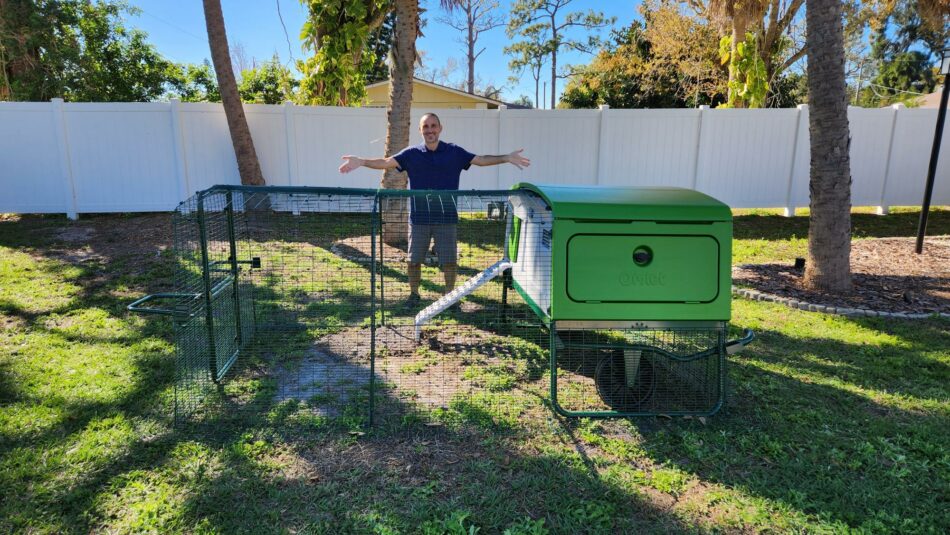

This entry was posted in Chickens
Chickens make great backyard pets for families of all ages and locations. While traditionally thought of as farm animals, flocks of chickens are now frequently gracing the backyards of urban and rural dwellers alike. A common question among aspiring or new chicken keepers is: how many chickens should I get? Here’s a guide to choosing the right size flock for your family, and how to comfortably house them.
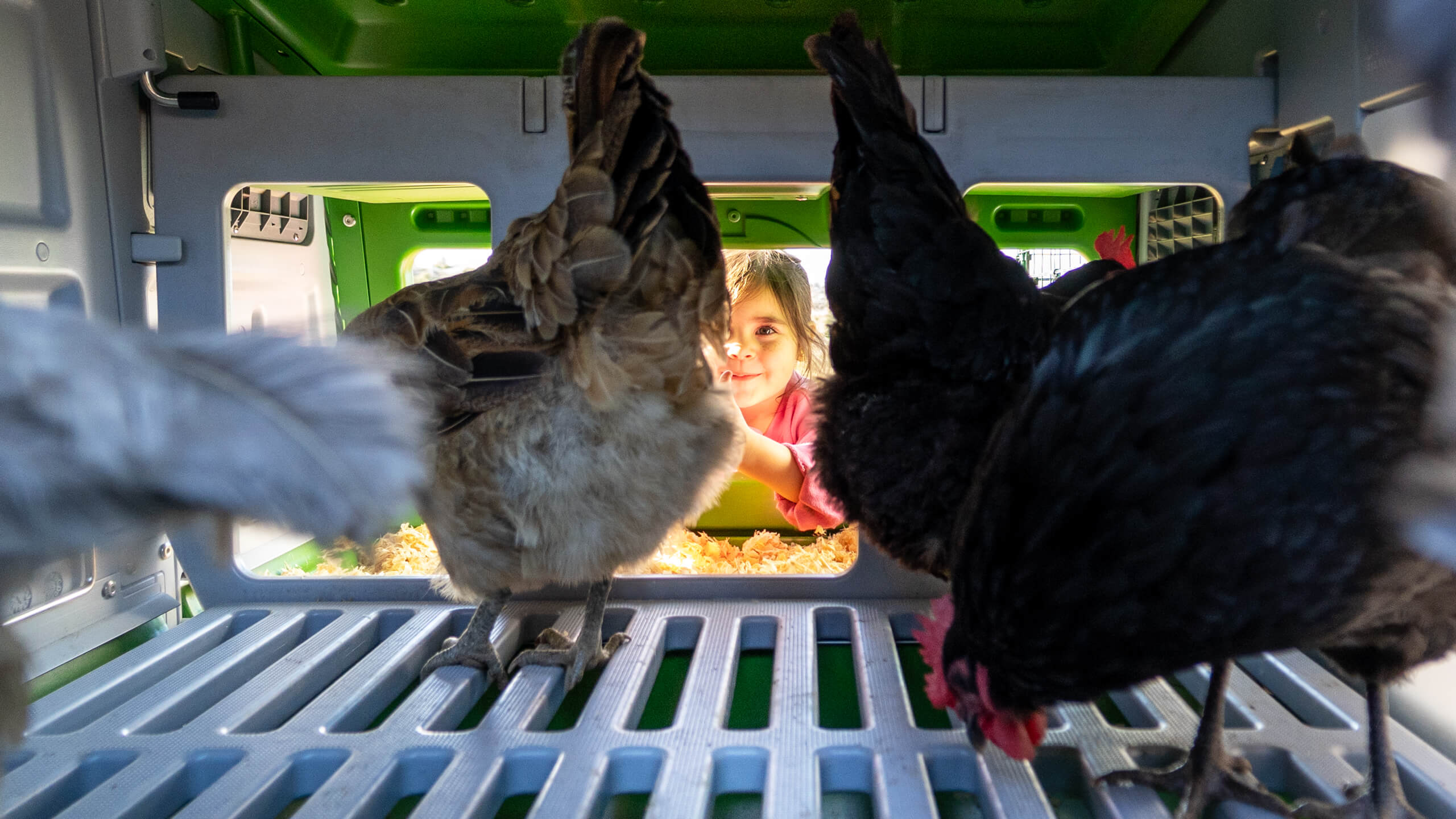
What’s your current setup?
If you’re looking to expand your flock, think about your current setup. Chicken math is the phenomenon that occurs when a chicken keeper sets out with the idea of keeping a predetermined number of chickens, but ends up with quite a few more. This inevitably happens to chicken keepers at some point — mostly because chickens are just so much fun to keep.
With chicken math in mind, consider if your current setup can accommodate additional hens. Chickens need as much space as possible outside of their coop to keep them fit and happy, and their coop should be large enough to allow everyone to have a safe and comfortable roost at night. Up to 4 or 5 hens can share the same nesting box, but growing flocks need more than one nesting area to maintain healthy laying habits.
If you’re new to keeping chickens, consider how many eggs you’ll need for your family, and how involved you’d like for your children to be. Chickens make great pets for families with children, but some setups are easier than others for children to open, close, and collect eggs from. You can keep chickens with other pets, but they’ll need plenty of space to spread out, and their own respective areas for sleeping and eating.
Chicken-keeping restrictions
In addition to your lifestyle, you’ll need to take into account any chicken-keeping restrictions that may apply to your property. There are laws about keeping chickens, usually at the city level, but your home may also be subject to local zoning or homeowners association (HOA) laws. Always contact your HOA (if applicable) along with your city’s zoning office to see if you’re allowed to keep chickens on your property.
Most laws restrict:
- The number of chickens you can keep
- Owning a rooster
- The size and placement of chicken coops or runs
You may also need a permit in some cities in order to keep chickens. These are typically purchased annually.
If the laws that your property is subject to limit the number of chickens you can have, you won’t have to worry about chicken math, as your flock limit will be set for you. For these situations, purchase the largest chicken coop that will comfortably house the number of hens you can keep.
Space considerations
No matter the size of your flock, they’ll always be happiest when they have as much space as possible. For chicken keepers that don’t have restrictions on flock size, an extra large chicken coop is the best option. Omlet’s chicken coops are rated for various flock sizes, but the Eglu Pro Extra Large Chicken Coop is perfect for growing flocks and chicken math on the horizon. The Eglu Pro can house up to 15 small breed hens — but it’s not just for large flocks. Your smaller flocks will appreciate the additional space and nesting areas, and you’ll appreciate the option to add more chickens as you see fit without crowding being a concern.
Benefits of a large flock
Chickens are easy and fun to keep, and unlike other types of pets, it doesn’t matter if you have 4 or 20 — their care and your routine remain the same. Thinking about keeping a large flock? Check out these benefits of having more chickens.
Egg production
More hens means more eggs. If you’re looking to supply fresh eggs for your family, you’ll need a steady supply of eggs. A hen lays an egg roughly every day and a half, so if you eat eggs daily, each member of your family will need one and a half chickens. Practically speaking, you should aim to have 2 hens per member of your family if you want enough eggs to go around.
Increased pest control
More chickens also means more pest control. Chickens eat all sorts of backyard pests, including:
- Spiders
- Scorpions
- Grubs and worms
- Grasshoppers
- Ants
- Fly larvae
Your chickens can help you in your garden too. By using chicken fencing, or by strategically placing their chicken run next to your plants, you can let them control pests without damaging your garden.
Flock diversity
Having more chickens gives you an opportunity to keep different breeds. You can incorporate ornamental breeds with your laying breeds of chickens to add a touch of whimsy to your flock without sacrificing egg production. Dual purpose chicken breeds can also add variety to your flock due to their various sizes and colours.
Omlet and your flock
We’ve created the perfect chicken products to help you keep flocks of all sizes healthy and happy for years to come. Whether you’re new to chicken-keeping, or are a seasoned flock raiser, our Eglu Pro and Walk In Chicken Run are just the right size for small and large flocks alike. Give your chickens the space they crave, or give in to your impulse to bring home more hens — with the Eglu Pro, there’s always room for more.


This entry was posted in Chickens
With chicken season hatching all around, we checked in with Omlet Ambassador Madison, who was kind enough to feature in our film for the Eglu Cube – see if you can spot her!
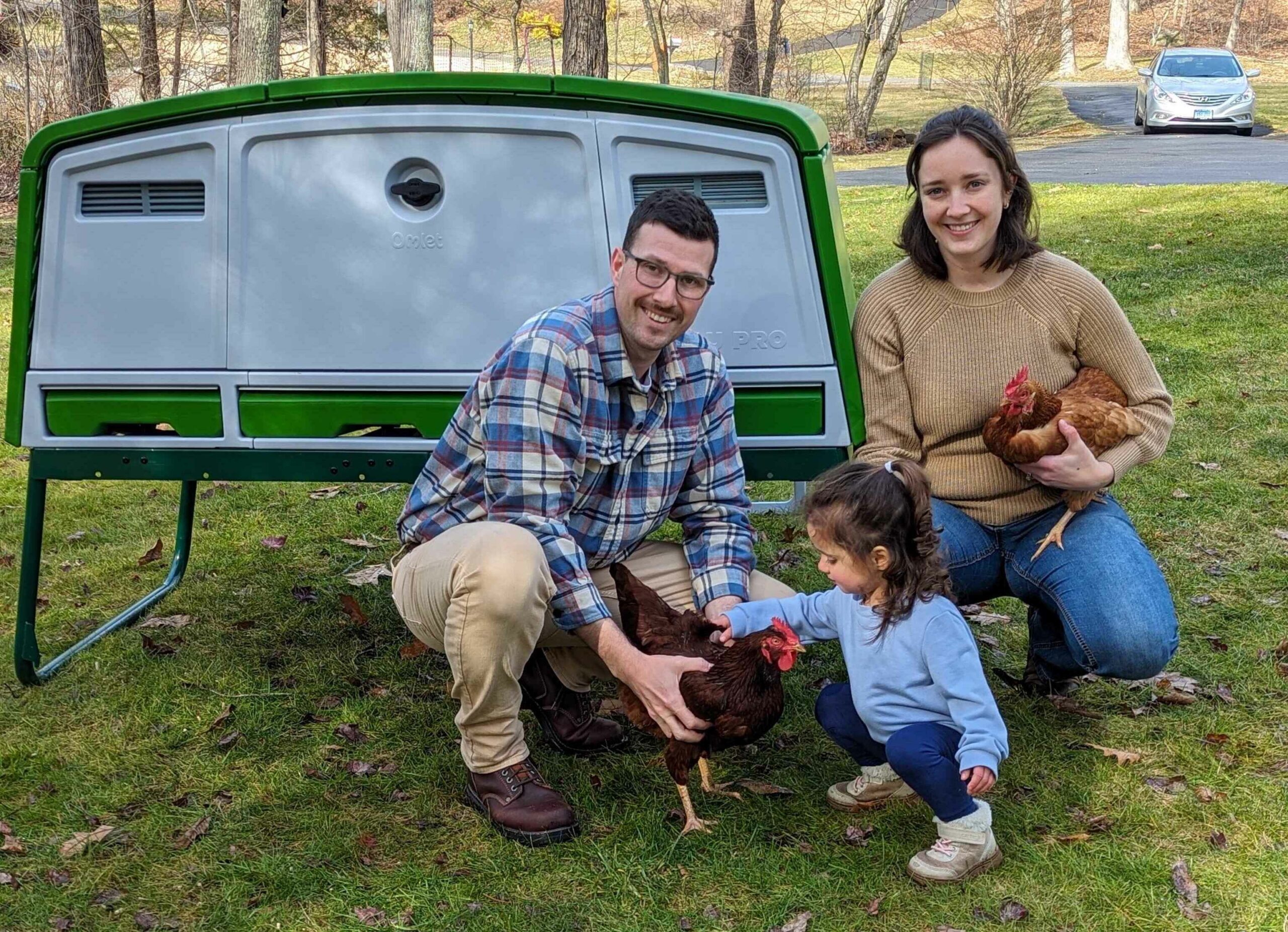
I know you’ve already got your Eglu Pro – how did the chickens react?
So, we put it together in the garage, and once we’d built it, we took the chickens in to show it to them, and it was so funny, because they made a beeline for it. They went straight to the nesting box and were having a real nose around. Instinctively, they just knew it was for them! You could tell they loved the LuxPanel too; they clustered around behind it, straight away.
How did you come to be an Omlet Ambassador?
I’ve worked with Omlet as an Ambassador for about a year. We went with Omlet out of the gate – we did lots of research. So we were weighing up the options, whether to do prefab, or to construct something ourselves, or go second hand. Then I stumbled on an advert for the Eglu Cube and that was it – I said to Nick, “We have to save up and get this.” With the weather in New England, I was already worried about wood rotting and the upkeep that comes with wooden coops. I know how fast wood degrades – it’s just not worth it, especially somewhere like this, with a good deal of snow. Yes, as an upfront investment it’s more expensive to go with Omlet, but we’ve had our girls for four years now, and I’ve saved that money back – because there’s no upkeep needed, no degradation.
So, money well spent?
Honestly, I absolutely love it! I’m so glad we did the research and then did the Ambassador program – going to see an Omlet coop up and running, and talking to a chicken keeper about their experience with Omlet, that really helped. It’s actually why I became an Ambassador in turn – I really believe in the products and I’m glad to pass that advice on to others in the same position as we were once.
What put you on the path to chicken keeping?
Well, we moved from the south, where we were really boxed in; there was no farming zoning. So we came to New England and we were lucky – we found this house with two acres, in a really farming positive area. Most states or areas have some regulations but there are no stipulations here – we could probably get goats and alpacas or whatever if we chose to – but we’re happy with chickens for now!
We started with five – we got them when they were a few months old. We bought our Eglu Cube with a run, and initially the plan was to let them out to free range by day. But it just didn’t work – we have so many predators. Just nearby, we have four bald eagles, cooper hawks, and foxes. We thought that with enough trees around, they might be OK, but a hawk flew low, through the trees and landed. So we realized we had to go a different way. We added a Walk In Run to our 6ft attached run, and we kept our set up stationary from that point. We started off with a 9×9 Walk In Run, but we’ve added an additional 6 feet. The modular design is great for that – you can keep improving and adapting your set up. Our flock has a great space and they’re safe from predators, which gives us peace of mind.
Tell me about your flock – what breeds do you have, and what are they like?
We have nine chickens in total, we have six Rhode Island Reds, one Golden Comet, one Welsummer and a Silver Laced Wyandotte. She is by far the fussiest. She’s just too pretty! The others are so friendly, but she’s a diva – you can’t catch her. The Rhode Island Reds are super – big, hardy, friendly. They’re not fancy but they’re lovely and good layers.
Our initial five were a mixed bunch we got from a farm – we just went in, caught what we could and took them home! There are three left – one passed naturally, and one we sadly lost to the hawk when we were still trying to free range. The three of the originals we still have are called Hennifer, Jebecki and Cher.
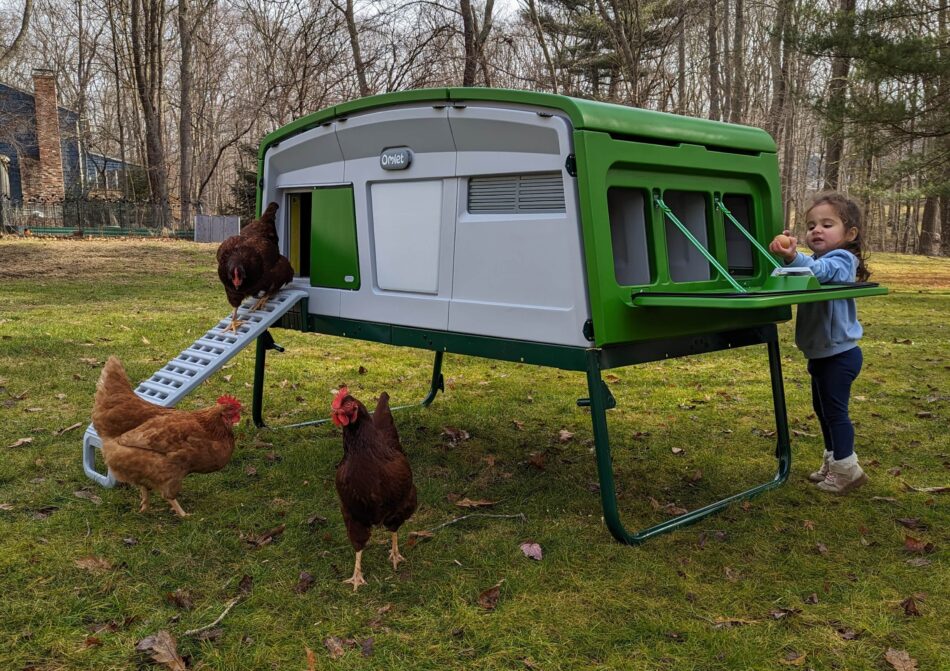
So how did you get to nine?
Well, chicken math I guess. We weren’t planning on getting more, but then we saw a post on a local group, and that they were Rhode Island Reds. I had wanted to get some Rhode Island Reds for a while, so we went for it, and yeah, three became nine! Unlike the originals, their markings are identical and Nick and I can’t tell them apart – so they’re just the girls. Maybe our daughter will name them when she gets older.
How do you feel life has changed since getting your flock?
It’s funny, but now, we’re known as the chicken guys – and we love it! Everyone knows, oh Madison and Nick have chickens. We’re the experts, people will come ask us about chicken keeping and we’ll always like talking about what we’ve learnt. We’re known for our fresh eggs too, we have so many – a lot of people come for them. It’s so lovely to give them away. But we’re actually going to start selling them, as we have so many we can’t give them away fast enough!
Then there’s the family side of the routine. We have a 2 year old, and now that she’s getting older she loves collecting the eggs and feeding the chickens – some will sit still and let her pet them, which is sweet. We’re really looking forward to teaching her to care for them. We love when we go to my in-laws, they always have a baggy of scraps for the chickens. The girls love that – they go crazy.
They like getting treats?
Absolutely! If they’re happy, or have some new variety in their life that they’re enjoying, we notice straight away that we get more eggs. So it could be a new toy – we made them a sand bath recently, they are so happy – it honestly makes them so happy. And when they’re really engaged and happy, they lay more.
That’s lovely – what else can you tell me about their characters?
They play with our dog! He’ll run up and down alongside the run, and they run up and down with him – it’s hilarious. We have our alpha chicken, she’s grown rooster spurs – she’s in charge. If we could let them free range, she’d be our attack chicken. She’s very nosey – if she sees us out in the yard, she stays out watching us, keeping a beady eye on everything that’s going on. She has to be at the centre of the action! If the dog gets too close, she pecks his nose and he jumps back, but then they’ll keep doing it, and you see it’s a game. He gets all excited and the rest are squashed up to get away from him, because he’s big, like 50lbs, but she’ll keep playing with him and is totally fearless.
What would you say to anyone considering starting out with chickens?
For starters, I would definitely gush about the Omlet products – I would say, you absolutely have to get an Eglu Cube or an Eglu Pro and you have to get a Walk In Run. Then, their life is good and yours is easy. I think my other top tip is to trust your gut. The chickens will let you know if something is wrong. As long as you have the right protection – from the breeze, from the sun, from the snow, the rain and from predators – then they are going to be great outdoors. Just make sure you have a set up that protects them, keep them watered and fed and off you go. You’ll find your way and you will love it. Oh and bless the creation of the Autodoor! We used to let them out of the coop and shut them in at night by hand and as soon as the Autodoor came out it was a “Forget everything else, we have to prioritize buying this!” situation. If you’re getting chickens, get an Autodoor!
Ha! Yes, we often hear that! So, Autodoor factored in, chicken life’s a good life?
Absolutely. I think it’s partly because it’s such a nice routine. It helps us stay grounded and connected to running our household. It’s nice to know we’ll always have fresh eggs – breakfast, quiche or whatever, but it’s having that sense of daily routine that brings you all together. It’s really fun to work on their area on the weekends, especially as it gets warmer – we love finding them things to do. We bring in old logs from the woods for them to climb on, or branches so they can peck through the dead leaves. It’s restorative.
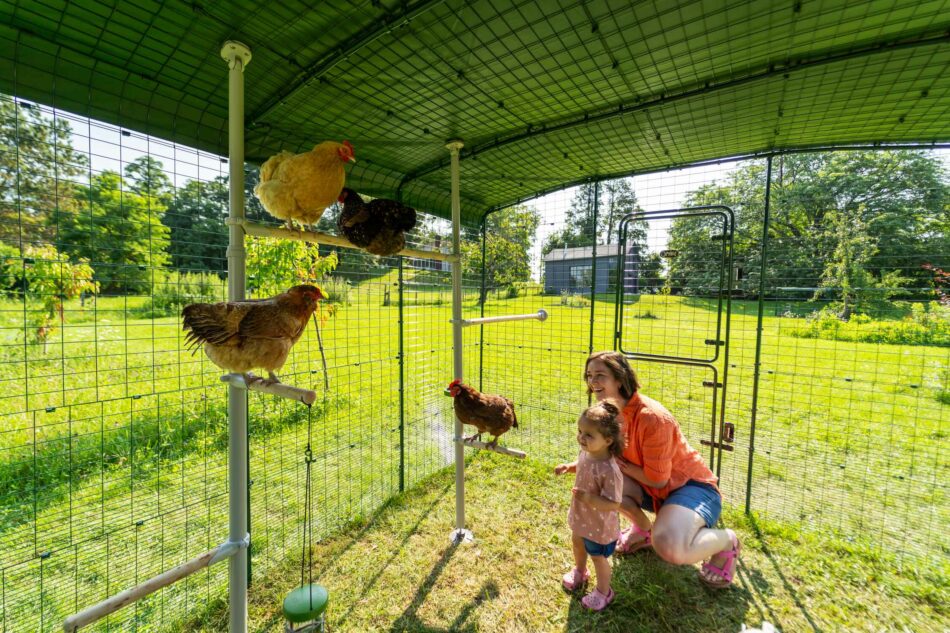

This entry was posted in Chickens
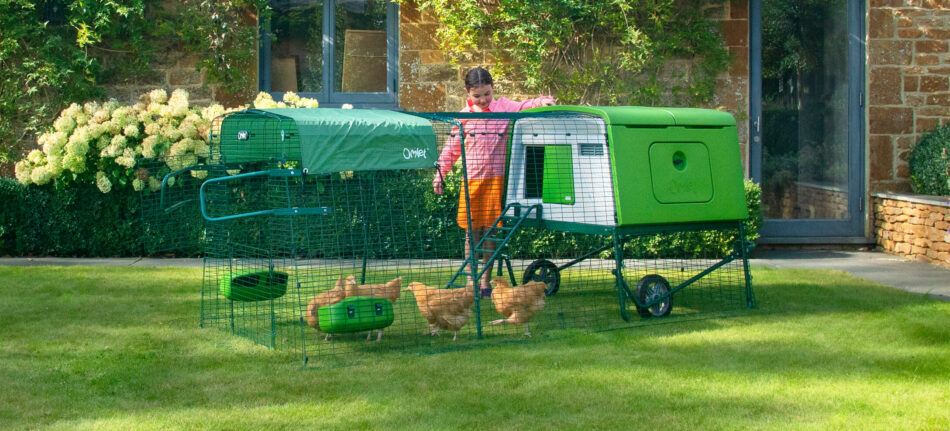
Chickens are unique pets that bring their keepers a sense of peace and tranquillity. Ask anyone who has chickens, and they’ll tell you that there’s something about watching chickens scratch the ground that instantly relaxes them. But there are 10 things you should know before keeping chickens. We’ll explore these important points to consider before bringing home a flock, and how to ensure success from the start.
10 things you should know before keeping chickens
Chickens aren’t just found in barnyards now. All across the world, you’ll find both urban and rural families adding chickens to their family. From gardens to wide open spaces, here are some helpful things to know when keeping chickens.
1. You’ll become obsessed with chickens
Most people aren’t entirely prepared for the amount of love they’ll have for their flock. What starts as a hobby will soon become an obsession – but a healthy one. More time spent outside, fresh eggs, and the companionship that chickens offer helps to reduce stress and create a healthier lifestyle. Just don’t be too surprised when you start shopping for chicken-themed clothes and decor, and researching all the fun things you can do with your chickens.
2. Some chickens can fly
Also not as much of a problem if you have a lot of space, but potentially problematic if you have neighbours. Some chickens are capable of scaling 6 foot fences and sailing straight into a neighboring yard. While chickens aren’t capable of sustained flight, a determined hen can certainly clear a fence when something piques their curiosity. To prevent flight, you can trim your chickens’ flight feathers, or choose breeds that can’t fly well. Silkies can’t fly due to the texture of their feathers, and large breeds like Brahmas or Orpingtons are too heavy to get far off of the ground.
3. You can’t have just one
Chickens are flock animals, and thrive in the company of others. A chicken kept alone is a lonely chicken, and will quickly become depressed. You’ll need to keep at least 2 chickens together, but ideally at least 3-4 in order for them to form a healthy chicken pecking order. This hierarchy is essential to the wellbeing of chickens, so keeping at least 3 chickens at a time is enough to satisfy this structure.
4. Pick breeds appropriate for your climate
Not all chickens are built for any climate. Ornamental breeds like Frizzles and Silkies are adorable to be sure, but they aren’t designed for extreme temperatures due to their unusual feathers. Breeds with large combs like Leghorns or Rhode Island Reds are more prone to frostbite in freezing temperatures and need to be watched closely in severe winter weather. Heavy breeds or those with small combs are usually not as heat tolerant, such as Wyandottes.
5. Even hens can make noise
This isn’t an issue for rural residents, but people living in neighbourhoods need to be careful when selecting their chickens. Roosters are usually not permitted within the city limits, but chicken sounds that hens make can reach a disruptive level. Some chicken breeds are more prone to calling out after laying an egg for example, which can get the entire flock going. It’s also a good idea (and sometimes a requirement of your neighbourhood) to get your neighbour’s consent before bringing hens home.
6. Check your local regulations
Always check to make sure that your property isn’t subject to rules and regulations about keeping chickens before getting your heart set on them. Most cities and homeowners associations (HOAs) welcome chickens, but some may not. It may also depend on the zone your property is located in, or how big your property is. You may also be limited on the number of chickens you keep, and whether or not roosters are allowed.
7. Predators pose a problem
No matter where you live, there will be chicken predators that will pose a threat to your flock. Keeping your chickens in a predator-resistant chicken coop is key to keeping them safe from harm.
8. Be careful with other household pets
Similar to wild predators, your other household pets may also pose a threat to your flock. Keeping chickens with other pets can be done, but precautions must be in place. As prey animals, chickens startle easily and can incite a prey drive in dogs and cats.
Always introduce your dogs and cats to your flock slowly, and through the safety of a secure chicken run. With a slow and steady approach, you’ll be able to evaluate the level of interest your other pets have in your flock.
9. They’re excellent pest control
When able to patrol the garden, or within a specified area of chicken fencing, your flock will exterminate insects from your property. Chickens will eat anything from grasshoppers and worms to earwigs and spiders – making your yard a much more enjoyable place for your family. When allowed near gardens, chickens can provide excellent assistance in keeping your plants bug-free.
10. Take caring for them seriously
Chickens are fairly self-sufficient – they stick to their routines, forage for their food, and can visit the feeder for their pellets when needed instead of gorging themselves all at once. It may be tempting to leave them to their own devices, but just like any pet, they are reliant on their humans in order to feel their best. Incorporate caring for your chickens into your daily routine, and get your family involved. And, when you go out of town for more than an overnight trip, be sure to find a chicken sitter to care for them while you’re gone.
Omlet and your flock
With our ingeniously designed chicken products, you’ll be able to keep chickens with confidence. Our chicken coops, chicken runs, and chicken toys and accessories make your experience as unique as the flock you keep. Preparing yourself by knowing what to expect before keeping chickens, along with our beginner-friendly products will ensure success from the start and ongoing enjoyment with your flock for years to come.
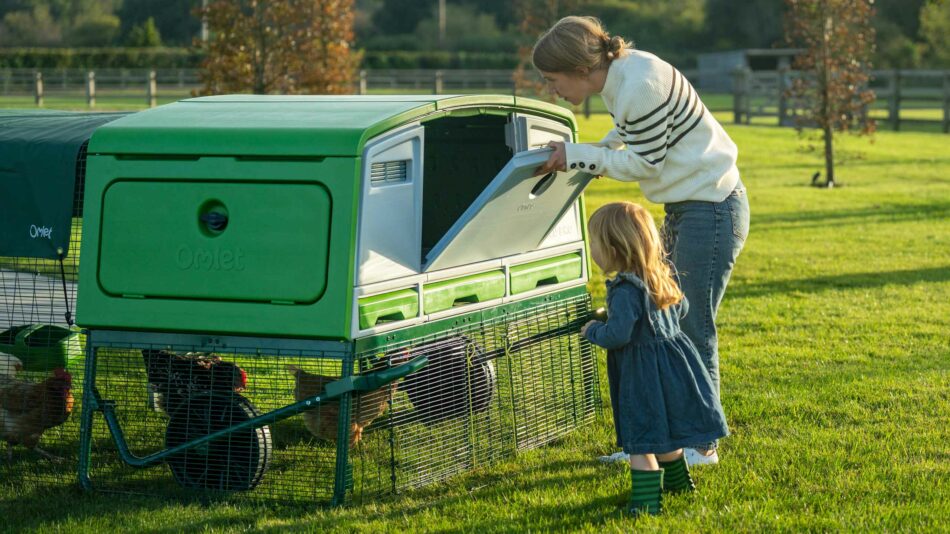

This entry was posted in Chickens
“they’re all characters. I’ve had some shy ones, I’ve had some you really need to kick out the bar at the end of the evening!”
We love to see our designs out in the world, being enjoyed by chickens and people alike, so we were thrilled – and more than a little intrigued – when we saw an article featuring hen hotelier Kat. We caught up with her for a chat on all things chicken.
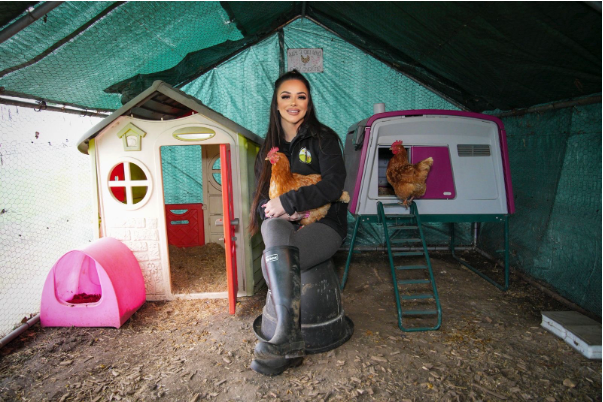
We loved the piece on your hen hotel in the papers. How did your story get picked up by the national press?
Actually it was my local paper that picked it up and it just snowballed. I’ve even been on ITV. I think it shows that people are getting more interested and aware of chickens as pets – they’re so underrated. Now I can help spread the word.
Where I live in Kent, I get a lot of walkers past our garden, who buy the eggs and they often stop and talk and ask questions. It’s almost a chicken viewing point! I’ve got an Omlet Freestanding Perch there that the bantams LOVE. I honestly think they love posing and showing off to passersby, which is hilarious. But it’s great because I want to educate people – if you don’t have chickens you probably don’t know just how full of character and interesting they are. Mine are my pets, my girls, and I’d never be without them.
Have your chickens changed since finding fame? Who are the primadonnas?
In my flock, I’ve got 5 at the moment, all rescued or rehomed. They’ve all got their own characters, but there’s one in particular who is the most confident chicken you could ever meet, a real queen bee. She’s called Sally – I named her after the lady I got her from. She gets involved in everything. She’ll jump on my shoulder when I’m cleaning. She was in the shoot with the photographer for the newspaper and she totally played up to it and did everything he wanted. A born performer.
How about the others? Any other big characters?
They’re all so different. Some are shy, some are happy to be picked up. Edwina, she’s always behind me, pottering. She’s very gentle, happy to be cuddled, unflappable. Edwina comes to nurseries with me.
Nurseries? As in children’s nurseries?
Well, I do educational workshops – always free, I don’t charge. We’ll go into local schools and talk about topics like free range hens, what happy eggs look like. I want to spread the word and the love. Edwina has a little mesh carrier suitcase with wheels on that she sits in and peeps out of and she travels in that.
That is so nice, such an important thing for children to understand. And great that Edwina has the right temperament. What about other chickens though – do your girls ever come into contact with your guests?
So for boarding, I keep hotel customers – I call them the hen parties – quite far away, because birds are sensitive and territorial, so it’s important to not stress or disrupt them. So on arrival they go straight down to boarding, where I do some simple health checks to make sure they’re mite and lice free.
We’re lucky, we have 2 acres, so our holiday hens are far enough away that they can stay apart and still have plenty of space. It’s more relaxing, no squawking. I put a lot of thought into the design when I set it all up.
That’s interesting you mention design; at Omlet we are always asking how we can invent better, to make caring for chickens more instinctive and enjoyable. As a loyal Omlet customer, did that affinity for design attract you to our products?
I think within the chicken community, Omlet is a household name. When I went into chicken keeping myself, there was no other option. It had to be Omlet. Because my mentality is, if I’m going to do this, I’m doing it properly. With wood, things harbour. You just don’t know what’s lurking in the cracks. When I set up the hen hotel, I knew I wouldn’t use something for my boarders that I wouldn’t want for my own chickens. So it’s all Omlet: the coops, the perches, the swing, the tarps. The lot!
It sounds lovely! What room service do you provide – how do you keep the place clean?
I think keeping the standard of cleanliness you need can be time consuming, because you have to make sure there’s no risk of bad hygiene or disease. But again, if you enjoy what you do it doesn’t feel like work. I have got to say it’s the ease of the Omlet design – it is so easy to take apart and jet wash – that really does make a difference. The products I use make it much easier.
Do you ever get any rowdy customers?
Haha, yes. Like I said, they’re all characters. I’ve had some shy ones, I’ve had some you really need to kick out the bar at the end of the evening. Some are louder than others, so yes, definitely a few rowdy ones. They’re like women – some are just louder than others!
What’s the most rewarding part of running a hen hotel?
That’s so hard. I sound so sad but I just love chickens. I think it’s a privilege to have pets. And I really do think chickens are so underrated – I feel so lucky I get to have them, that there are so many rescue opportunities. They are little souls, beings. You can see it in their eyes. I want to gain them the respect as a pet that I think they truly deserve. So to the question, it’s all rewarding.
And does the rest of the family get involved?
I have a 5 year old. He loves going to see the holiday hens because they’re different to ours, so he likes me to take him down to see them. So yeah he does get involved, but unsurprisingly the cleaning’s all left to me! My partner just wants to know how many eggs we’ve got.
Ha! Well that’s one good reason to have chickens. In fact, my last question was, why chickens? What would you say to anyone thinking about starting their chicken keeping journey?
Well, I mean my initial answer would be, do it – it’s the best thing you’ll ever do. But like any animal they need care, they need love, they need attention. But they really do return it. So, yes, do it. And do it properly. Open up your heart and rehome some chickens!
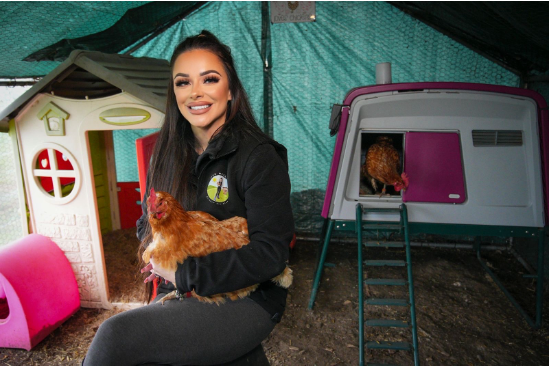

This entry was posted in Chickens
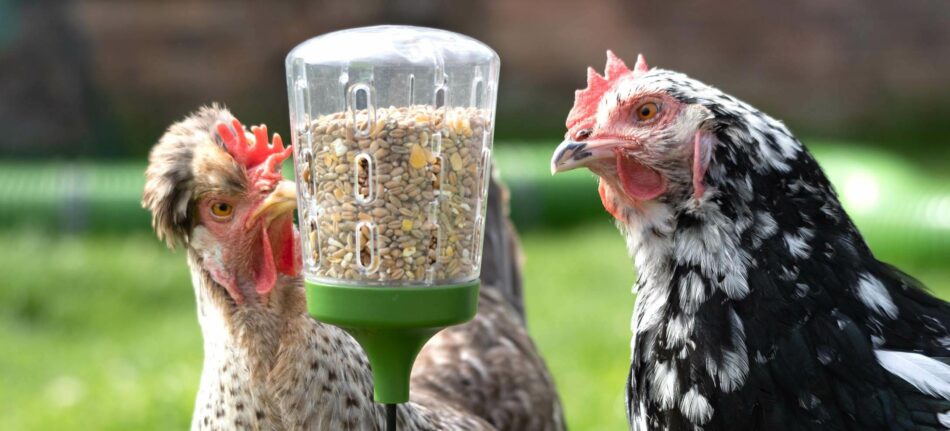
Reading through different chicken breeds and their characteristics can be confusing. The many traits, appearances, and sizes of chickens make them a very diverse species. In our Chicken Breeds 101, we’ll uncover the most commonly used terms and address pressing questions that have to do with breeds of chickens.
Chicken breed grouping
Some common chicken breed groupings include:
There are also 6 classes of chicken breeds, based on where they originated:
- American
- Asiatic
- Continental
- English
- Mediterranean
- All other standard breeds
Within these groupings, there are size groupings of:
What is a bantam?
There are standard sizes of chicken breeds, and there are also bantam sizes of many breeds. Bantams are miniature versions of their standard counterparts. There are also “true bantams”, meaning they have no standard size and come only in their petite varieties. True bantams include:
Bantams take up less space, so they’re a great choice for small spaces like backyards.
What is a heritage breed?
Heritage breeds are those that were raised by our ancestors. All of our modern chicken breeds were derived from these. Several heritage breeds are endangered due to the emphasis put on developing new breeds. Breeding efforts have helped stabilize their populations, allowing them to grace common backyards once more. Some heritage breeds include:
What is an ornamental breed?
Ornamental breeds are bred for their looks instead of their productivity. As a rule, they tend to lay fewer eggs and be less heavy in stature. Some examples of ornamental breeds include:
These types of chickens make excellent pets and fabulous yard art.
What is the largest chicken breed?
The Jersey Giant usually takes the cake for the biggest bird on the block, but Brahmas are a close second. On average Jersey Giants are the largest, but a Brahma currently holds the record for largest chicken.
Which chicken breeds lay the most eggs?
Breeds of hens that have earned a reputation for their prolific egg laying are those that usually lay around 250 eggs per year. In comparison, ornamental breeds lay between 120-150 eggs per year on average.
Leghorns are the most consistent laying breed, with an average of 280-320 eggs per year. Other chicken breeds known for their egg production include:
How can you tell which colour egg a hen will lay?
Several chicken breeds are known for their colourful egg laying abilities. Egg colour is determined by genetics, and a hen will lay the same colour their entire lives. All egg shells start out white, but if a hen carries a gene that causes pigmented eggs, it will be applied in the shell gland before being laid. These colours don’t affect the egg’s taste or nutritional value, and don’t penetrate past the shell.
The chicken breeds that lay coloured eggs are either pure-bred, or the result of crossing a brown egg layer with blue egg genetics. The blue egg laying breeds that are crossed with other lines to produce different hues of eggs are Ameraucanas and Araucanas.
Some hens may give you a hint as to which colour they lay. By looking at their earlobes (the fleshy patch of skin on either side of their head), you may be able to predict egg shell colour. This isn’t always accurate, as some breeds like Silkies lay cream coloured eggs, but often have blue earlobes. But, in general, hens with white earlobes lay white eggs, and hens with red earlobes lay brown eggs.
Feather terminology
There are some terms that are used when talking about feathering. These are in reference to patterns on each individual feather, which gives the chicken its overall patterned appearance.
- Barred — alternating dark and light stripes
- Cuckoo — similar to barring, but with less defined lines
- Laced — edges of the feathered having an alternate colour
- Mottled — white-tipped feather interspersed throughout
- Penciled — fine lines of contour colour along the feather
- Spangled — white mid-section on feathers
How to determine the sex of chickens
Some breeds are “auto-sexing”, which means they can be determined as male and female upon hatching. These breeds hatch out with specific markings that are consistent with their gender. There are also methods of checking wing-feather length, but this method isn’t the most reliable. For breeds that don’t auto-sex, it’s usually difficult to determine gender until young roosters crow — typically between 4 and 6 months of age.
Omlet and all breeds of chickens
No matter which breed you’ve researched, or decided to welcome into your family, our chicken coops, chicken runs, and chicken-keeping essentials like the automatic chicken coop door give you an experience as unique as your flock. Discover how refining your chickens’ setup along with your knowledge is part of the amazing experience that is keeping chickens.
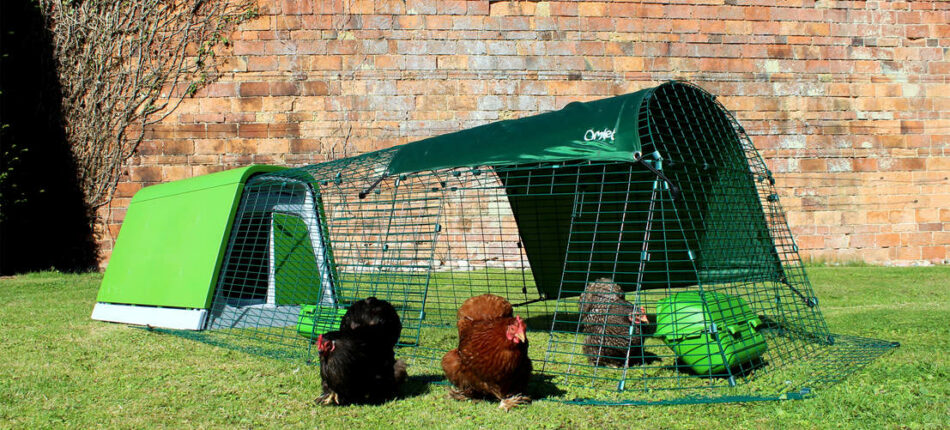

This entry was posted in Chickens
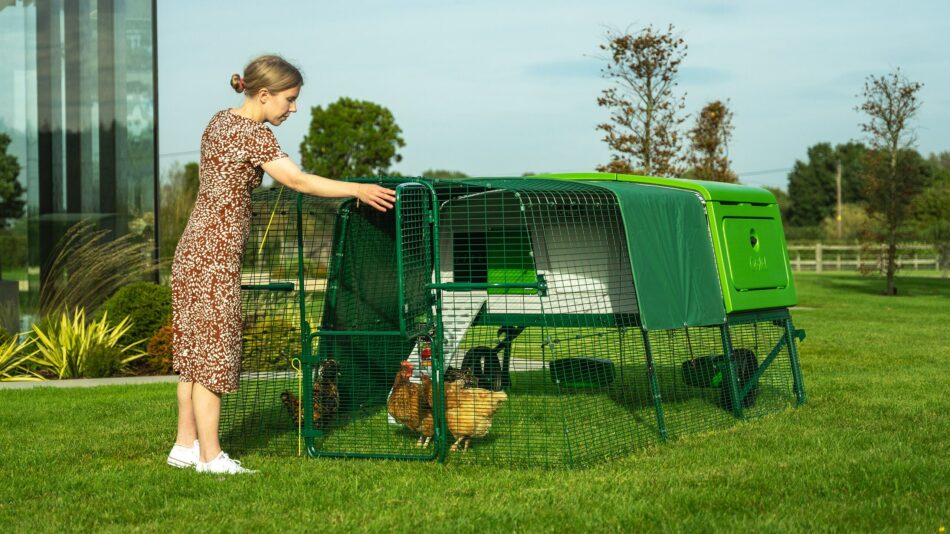
When thinking about outdoor hobbies, have you ever found yourself wondering, could chicken keeping suit my lifestyle? If so, you’re not alone. Keeping a backyard flock of chickens has grown in popularity as a way to reduce stress, provide fresh eggs, and increase time outdoors. Here’s a look at how chicken keeping can fit into your lifestyle — no matter where you live.
Reasons to keep chickens
There are several benefits to keeping a backyard chicken flock. In addition to their charismatic charm, chickens offer their keepers many benefits like:
- Fresh eggs
- Pest control
- Fertilizer
- Yard upkeep
- Compost pile assistance
But above all, chickens can form bonds with their owners that will last a lifetime. Depending on the personalities of your hens, these relationships can look similar to those you share with your dogs or cats.
Knowing some of the benefits that hens can bring, it’s time to look at the finer details of keeping a flock. Housing and caring for chickens has several options, allowing you to choose a method that integrates them into your lifestyle with ease.
Types of setups
There are several different ways you can design your flock’s setup. Mobile coops, chicken runs, and chicken fencing are all components of chicken keeping that can all be customized to suit your lifestyle. Some chicken-keepers opt to let their flocks free-range, but there are some risks associated with this practice.
Mobile and stationary coops
All of Omlet’s chicken coops can be converted into mobile chicken coops with the addition of optional wheels or handles, or purchased as pre-constructed chicken tractors. Chicken tractors allow you to easily move your flock’s coop and run around your yard to reduce overgrazing and fertilize your lawn. It also makes it possible to move all of your chickens to shelter quickly in severe weather events.
Chicken runs and chicken fencing
Stationary chicken coops can be attached to large walk in chicken runs, or placed inside of chicken fencing. This is a popular option for many chicken-keepers, which gives your flock a dedicated space in your yard. Chicken runs and fencing keep your chickens where you want them, and away from your garden plants or any other areas that don’t require their attention. You can also choose the substrate of your chickens’ run once they’ve grazed over the available grass.
The risks of free-ranging
Free-ranging is an option for chicken-keepers that aren’t subject to laws that prohibit flocks from wandering. But there are still several important things to consider before allowing your chickens to free range:
Flocks that free-range have access to additional nutrients, and can find their own chicken dust bathing areas — but these conveniences don’t come without risks. Your chickens are always safest inside of a sturdy chicken coop and run, with additional nutrition supplied to them through dried insects and herbs, seasonal hay, and fresh foods from your garden or supermarket will keep your chickens nourished without added risks.
If you do choose to let your flock free-range, be sure to take the proper precautions. Always close them safely in their coop at night, or schedule your automatic chicken coop door to close shortly after dark to keep them safe overnight. Avoid letting your chickens roam when you aren’t home so that you can monitor their whereabouts.
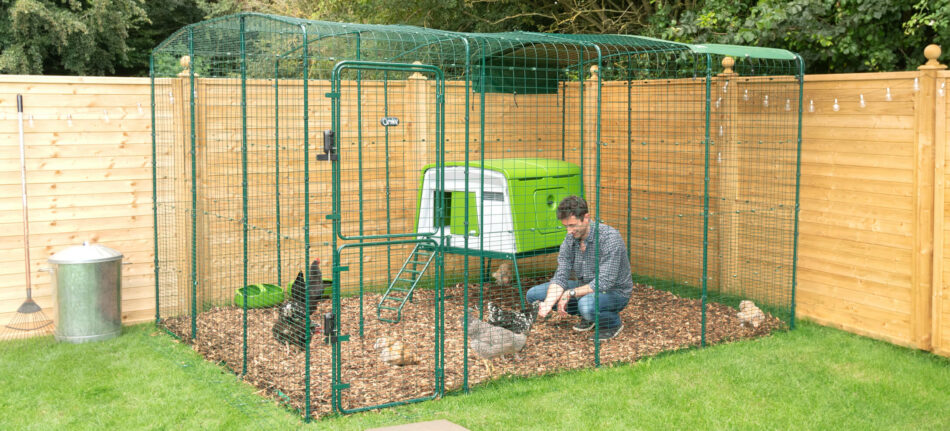
Daily routine
Daily routines are another area where each chicken-keeper can decide what works best for them. There are some routine tasks that need to be done, but with easy to clean chicken coops, they’ll only take minutes a day. Here’s an example of a daily routine with hens.
Morning:
Afternoon:
- Check the nesting box for eggs
- In cold weather, make sure water isn’t frozen; in hot weather, make sure water is topped off
Evening:
- Close your hens inside the coop
- Remove any leftover feed to prevent rodents from visiting
- Check the nesting box one more time
Leaving chickens while you travel
Chickens are fairly self-sufficient, and as long as the weather is mild, overnight trips shouldn’t be a problem. Extra food and water can be left out for quick trips, and the Autodoor will ensure that your hens are let out and tucked in on time. If you plan to be gone more than a day or two, you’ll want to get a chicken sitter to look in on your flock.
Flock sizes
Chickens are flock animals and need the companionship of chickens to thrive. It’s important to keep at least 2 hens together, but aiming to keep at least 3 or 4 together will allow them to establish a healthy flock pecking order.
Check the laws of the land
Before deciding on how many chickens you’ll keep, be sure to check with your city (if you live within city limits), county, or homeowners association (HOA) to see if your property is subject to any chicken keeping laws. Many laws that apply to keeping chickens will limit the number of hens you can keep at a time, where to place their coop, and whether or not roosters are allowed. Some properties are subject to minimum lot size requirements, and several cities require chicken-keepers to apply for a permit or license from the city before obtaining chickens.
Keep chicken math in mind
Once you have guidelines from the appropriate governing authority (if applicable to your property), you can decide how many chickens you’d like to have. Keep in mind that “chicken math” is real, and often strikes the unsuspecting chicken-keeper. Once you start a flock and discover their addicting attributes, it’s hard to stop at just a few hens. And so, a few hens often leads to many, resulting in more than you initially may have bargained for.
Leave room to grow
It’s always a good idea to invest in a setup that has room to grow your flock. Unless your property is strictly limited to 2-4 hens, it’s very likely that you’ll eventually end up with more chickens than you had in your starter flock.
The Eglu Pro houses up to 15 hens comfortably, and has increased safety features along with the easy-to-clean design of the entire Eglu chicken coop lineup. By choosing a large chicken coop, you’ll be able to add to your flock spontaneously.
Chicken lifestyle with Omlet
At Omlet, we make it possible to integrate chickens into your lifestyle. From urban backyards to rural barnyards, our chicken coops, chicken runs, and Autodoor make it possible for anyone to keep hens healthy and happy. Embark on your new adventure keeping chickens, and discover the joy hens can bring to your life without sacrificing your lifestyle.
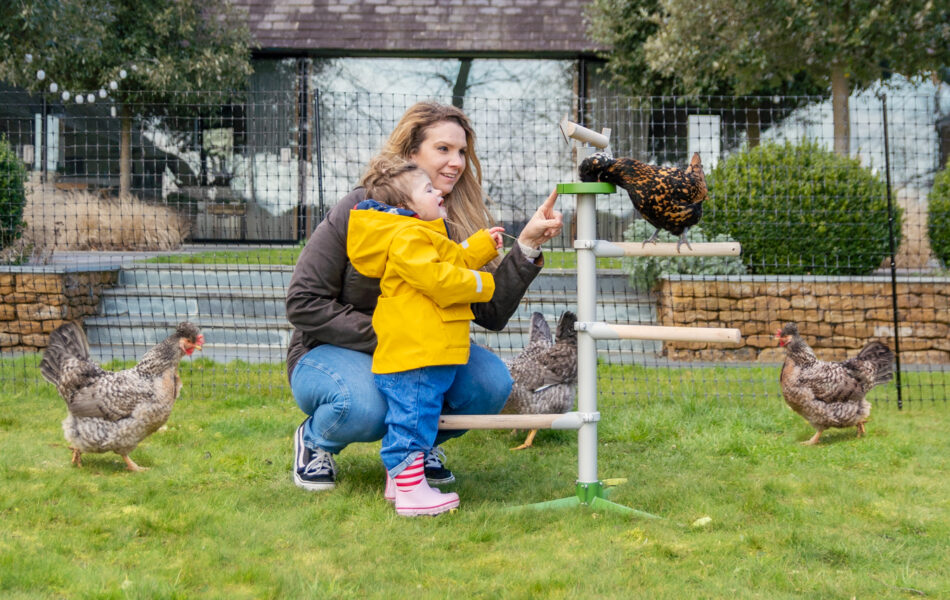

This entry was posted in Chickens
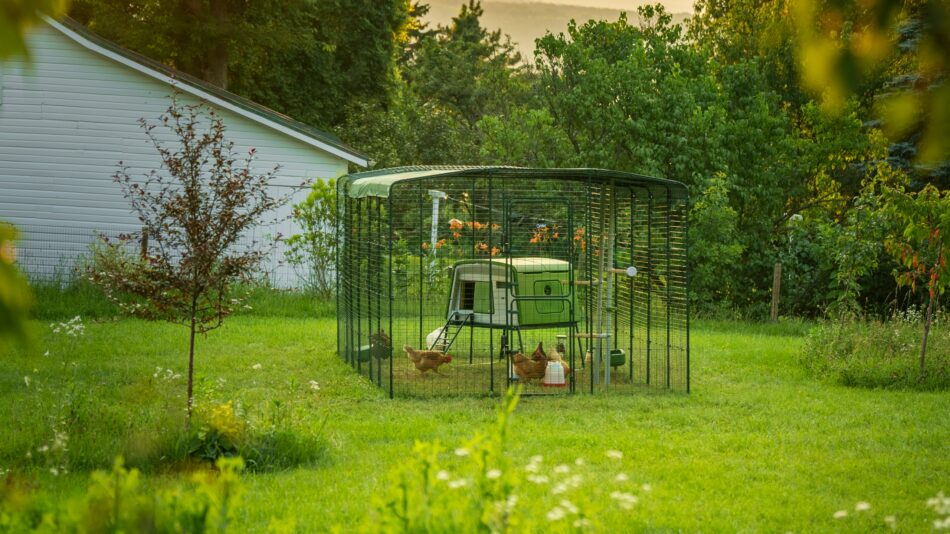
What is a chicken run? In short, it’s a confined space where your chickens spend time outside of their coop. But what makes a chicken run, how big they are, and what should be inside them varies widely between flock raisers. We’ll help you understand what a chicken run should consist of, where it should be placed, and why it’s an essential part of having hens.
Why hens need a run
Chicken runs are enclosures that are either attached to or surrounding your flock’s coop. Even keepers who choose to let their hens free range can benefit from a chicken run. They give your flock a designated, safe space outside of their coop. A good chicken run:
- Gives your hens space to forage and exercise
- Defends against predators
- Has a top to protect against the elements and aerial predator attacks
- Is roomy enough to accommodate the number of hens you keep
Not all chicken runs are created equally. The material, size, and arrangement of your chicken run will determine how well it serves your hens and you as their keeper.
What are chicken runs made of?
There are several different types of chicken runs available. Traditionally, chicken runs are made of wood and either chicken wire or hardware mesh, but the problem with these materials is that they deteriorate over time – leaving your flock vulnerable to chicken predators and the elements.
Heavy-duty welded wire chicken runs are a much better option. They can be attached directly to your chickens’ coop, or surround it as a standalone structure. All Omlet chicken runs are designed with anti-dig skirting that helps protect your flock from digging predators.
Weather protection for chicken runs helps keep your hens dry and warm in the winter, and out of the sun in the summer. The ability to add these covers to the top of a chicken run is just one of the many benefits of having a fully enclosed chicken run. The angled roof panels of our chicken runs help prevent water and snow from accumulating on the run, which maintains the structural integrity of the welded wire.
The different types of chicken runs
There are several different types of chicken runs available. When deciding what type of chicken run to keep your flock in, it’s important to determine your chicken-keeping style. Does your flock free-range, or do they need to be kept in a designated space? Do you need to be able to move your flock frequently, or is a permanent structure more appealing?
The best option for most chicken keepers is a walk in chicken run. Walk in chicken runs:
- Allow you to spend time with your flock
- Offer easy access to feeders and waterers
- Make use of aerial space
- Are fully enclosed to protect hens from every angle
- Can connect directly to Omlet chicken coops
- Surround any type of hen house placed inside them
- Give plenty of space for flock activities
- Can be expanded to any dimension to grow with your flock
- Are ideal for flock raisers that have a permanent run location in mind
If you have a free-range flock, alternative options include:
Chicken tractors are mobile chicken coops with attached runs of up to 12 feet in length. This setup enables you to move your entire flock and their coop and run around your property. Our easy-to-use chicken coop wheels and handles make it possible for just one person to relocate their flock in seconds.
Chicken fencing is for the ultimate free-range feeling. With a variety of sizes and the option to attach to the side of a structure, you can create an area of any shape for your hens to roam freely. Removable fence poles allow you to adjust or move as needed, while the mesh fencing keeps your chickens where they should be.
How to choose a chicken run
Choosing a chicken run is almost as important as choosing your chickens’ coop itself. It should work for both you and your flock, and fit in with your space and lifestyle. When choosing a chicken run, consider:
- If you’ll need to move the run, or leave it in one place
- Potential expansion options
- Time needed to clean the run
- Longevity and functionality
Choosing an easy-to-clean, low-maintenance chicken run is the ideal option for most chicken keepers. Rot-free materials with customisable configurations are the perfect solution for flocks of all sizes.
Top reasons to choose a walk in chicken run
The largest of chicken runs, walk in runs, allow keepers to enter their flock’s area without having to bend over, and give full access so you can customise and clean their space. Walk in chicken runs are perfect for keepers that:
Our step-by-step how-to-build videos make assembling your walk in chicken run a breeze. And, even after it’s assembled, you can customise the space and layout of your run. Add walk in chicken run partitions to give depth to your run or raise different breeds of chickens, or to have designated dust bath, play, or enrichment areas of the run. Our walk in chicken run can be expanded anytime, to any size, so your imagination is the limit when it comes to creating the perfect chicken setup.
Reasons to choose a mobile run
Mobile chicken coops can be outfitted with chicken runs that can be moved along with the hen house. Our convenient wheels and handles make it possible for just one person to relocate the chicken coop and attached run as needed. Smaller gardens or flocks can benefit from these types of runs, or those that free-range regularly.
Where to put your hen run
The ideal location for your chicken run is a flat, somewhat shady spot of your property. Natural shade helps in the summertime when UV rays are at their most intense, but partial sun is ideal for sunning and for warming up in the winter. Avoid placing your chickens’ run under trees with low-hanging branches, or where it could be in danger of falling limbs. Level ground makes for easier cleaning and assembling of your chicken run, and will help keep the run bedding in place.
You’ll also want to choose a location that makes caring for your chickens convenient and accessible. Choose a place that your water hose can reach easily and that has plenty of room for you to store their feed in bins close by. A spot that’s easily observed from a window in your home may also be a good idea – most chicken keepers love to watch their hens peck and play.
Essentials for inside your run
The bare essentials in any chicken run are quality feed and constant access to fresh water, so you’ll need chicken feeders and drinkers inside the run. Beyond those two necessities, you can offer enriching elements like chicken peck toys or a Chicken Swing to give them physical and mental stimulation.
Chickens will make quick work of grass inside stationary chicken runs, so you’ll need to consider adding bedding to the run once they’ve eaten it down to the dirt. Untreated mulch or wood chips, straw, pelletised bedding, hemp, or other soft bedding is ideal. Some keepers also use gravel around the perimeter of the run to reduce bedding loss and the presence of mud.
What’s the difference between a chicken run & coop?
All chicken runs have a coop, but not all chicken coops have runs. A chicken coop is a house that your hens use to sleep and lay their eggs, or seek shelter inside during storms or other inclement weather. The run is the outside portion of your chickens’ setup where they spend the majority of their waking hours.
First-time chicken keepers benefit from having an all-in-one solution, such as the Eglu Cube. This spacious chicken coop can house up to 10 hens, and the attached run can be expanded to up to 12 feet long. A walk in chicken run can be added at a later time by either placing the coop inside the run, or by purchasing a kit to connect the attached run to the walk in run from the outside.
Pet care with Omlet
Protecting your flock is at the forefront of our designs. With our exclusive hen houses, chicken runs, and extreme temperature protection for chicken runs, you can be sure that your flock is being protected and kept comfortable by expertly engineered products that are designed to last a lifetime. Whether your flock free ranges or stays in a run, we’ve got the products to help make chicken-keeping an enjoyable and effortless experience that will bring you closer to your hens, however you house them.
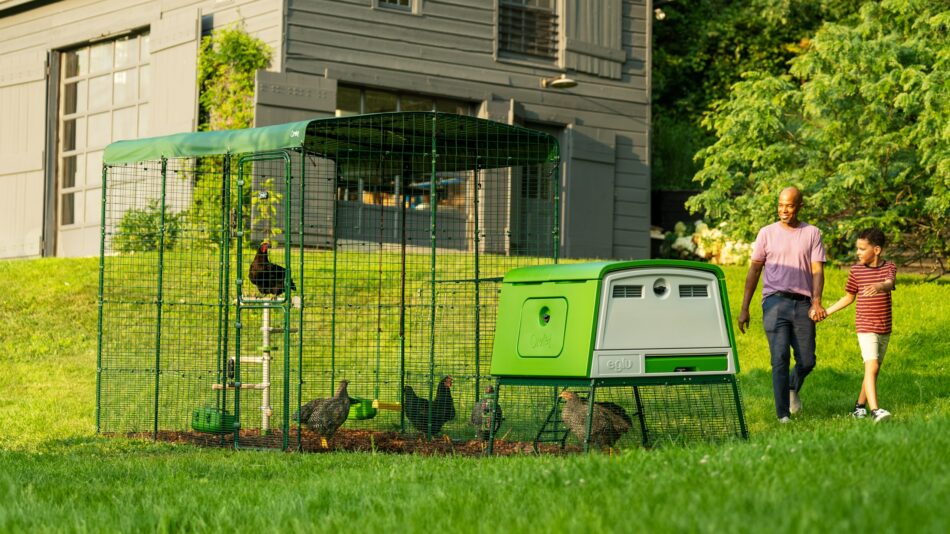

This entry was posted in Chickens
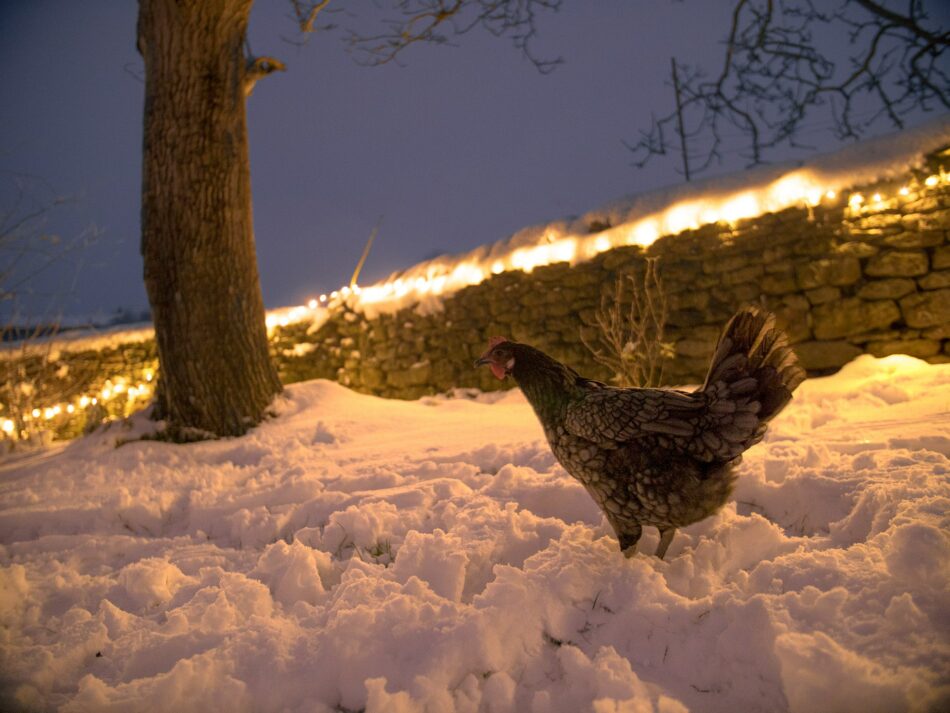
Winter is a fun and festive season for humans and chickens alike. Chickens fare much better in colder temperatures than in the heat, so the chilly days ahead are perfect for spending quality time with your hens. Find out how festive fun for your flock can keep their minds and bodies busy while building a deeper bond with you.
Are my chickens ok in the cold?
First, it’s important to understand that the majority of chickens fare better in the cold than they do in the heat. Even if you aren’t a fan of the cold, your hens are likely enjoying the winter season more than the sweltering summer heat. Assuming your flock is fully feathered at the end of their moulting season, they’ll be able to withstand temperatures below freezing. So, while you may be able to curl up by the fire with your furry family members, don’t feel too sorry for the feathered family outside – just bundle up and join them for some wintertime fun.
Bonding with your flock
Chickens can become very attached to their caretakers, making the bonds between hens and humans both unique and beautiful. In fact, hens make great pets for older people, and flocks are both fun and educational for children.
The cooler temperatures and shorter days of winter bring families and their furry family members closer together – but that doesn’t mean your flock needs to be left out in the cold. While they’re weathering the lower overnight temperatures in their insulated chicken coops, there are things you can add to their run and activities to enjoy along with your flock on a winter’s day.
Christmas treats
Special holiday treats can be served to your flock to help them enjoy the season. A chicken Christmas morning breakfast mash consisting of oats, raisins, corn, hot water and spices makes a festive offering that’s especially cheerful on a chilly morning. Bring your own cup of coffee or tea and enjoy a crisp morning with your flock and your respective steaming treats. These alongside protein-rich treats can be served in a Caddi Treat Holder to keep them up off of the frozen ground.
Fun in the run
One of the best ways to spend time with your flock is to extend their run space. This is particularly beneficial in the winter months, as they’ll have more room to move around and generate body heat. Cooler weather is the perfect time to add space with Walk In Chicken Run Extensions, or add a whole new area with Chicken Fencing.
Chicken Run Covers will shelter you and your hens from the snow while spending time outdoors. Clear covers allow warming rays of sun through, so that you and your hens can enjoy the elusive winter rays together. With the run or yard set up, you’ll be able to invite your hens to play some games that will warm their bodies – and your heart.
Games for your flock
Chicken toys help keep your hens warm by encouraging them to move more, and keeping them up off of the frozen ground. And, with your winter treat offerings, you can build their confidence and your bond with them as you teach them to come, perch, flap, or hop on command. Toys like a Freestanding Pole Tree are the perfect height to interact with your hens at waist level and teach them new tricks. Or, increase their reach with a PoleTree and visit with your flock face-to-face.
Other ideas for activities that you can enjoy with your flock include:
- Rolling a toy ball (usually those made for cats) filled with their favourite treat
- Creating a forage area with hay or straw and scattering scratch or other small treats throughout
Also consider posing with your hens in some of your family’s Christmas photos, or take some festive photos of your flock playing in the snow for a unique addition to holiday cards.
Omlet and your flock
Connecting with your chickens in the colder weather doesn’t have to be a challenge. Our Chicken Toys and Accessories are designed to bring you closer than ever to your feathered family members. You may not be able to bring your hens inside for the holidays, but making their season bright will keep them close to your heart. With a warm hen house like the Eglu Cube Chicken Coop and a spacious Walk In Chicken Run, your flock will keep comfortable in their winter wonderland while building an even more wondrous connection with you.


This entry was posted in Chickens
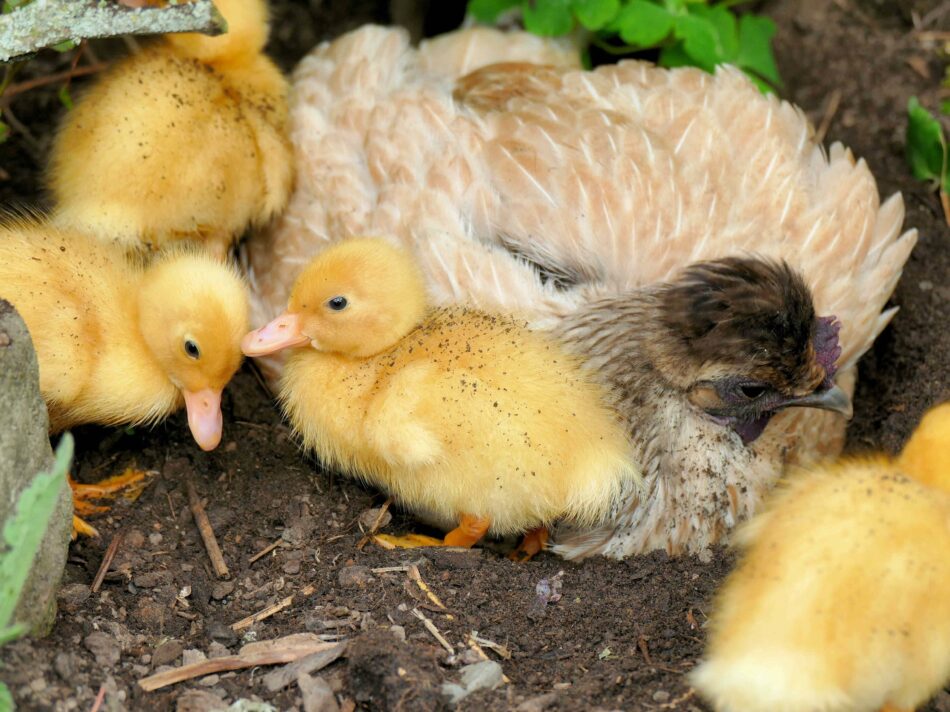
Can you keep chickens and ducks together? This may be a question you’ve raised as you’ve ventured further into the world of poultry. Ducks and chickens can cohabitate, but there are some modifications and considerations to take into account. For example, only female ducks (hens) should be kept with your chickens, and some adjustments need to be made to their waterers. Find out everything you need to know about keeping chickens and ducks together before diving into mixed-flock keeping.
Why keep chickens and ducks?
Chickens and ducks have similar dietary and space requirements, so they can easily be kept together. Both species can thrive as a free-ranging flock, or in coops and runs. Ducks also lay eggs, and depending on the breed, can lay as often as one egg per day.
In addition to adding variety to your egg basket, ducks offer an infusion of personality into your chicken flock. Their social behaviours are similar to those of chickens, but tend to be more laid back than hens.
3 tips for chicken and duck harmony
Housing and space
Ducks prefer to roost at ground level, while chickens seek out an elevated sleeping spot. For mixed flock keepers, this leaves a couple of different options:
- Create a roosting area for your ducks underneath your hens’ elevated chicken coop.
- Provide a ground-level hen house for your ducks.
The area beneath the Eglu Cube Chicken Coop can be utilised for your ducks by covering the sides with chicken run covers. You’ll also want to provide your ducks with a nesting box at ground level – which your chickens may utilize as well.
An Eglu Go hen house with the roosting bars removed works wonderfully for webbed-footed flock members. Most domesticated breeds of ducks will fit comfortably inside, but be sure to verify the size of full-grown hens of the breeds of ducks you’re considering to compare with the size of the Eglu Go. If you’re unsure, our knowledgeable team can help you decide if your ducks will be comfortable in one of our coops.
Beaks and bills
Chickens have beaks, while ducks have bills. Duck’s mouths are shaped mainly to forage in wetlands. Their flat, wide mouths have tiny hair-like structures along the edges called “lamellae” that filter their findings through water and mud. Because of the shapes of their bills, they need open container waterers – but not so large that they’ll want to climb in for a swim. A run-mounted chicken drinker is a great option for both species.
Because chickens have narrow beaks instead of wide bills, serving their scratch grains and treats in chicken peck toys and hanging dispensers will ensure they get their share of the daily allotment. Ducks can scoop grains and treats up quickly with their shovel-like mouths, potentially before more timid hens can get to them.
Create a swimming section
Ducks need access to water, especially during the warm summer months. Children’s wading pools or shallow water troughs make perfect swimming areas for small flocks of ducks. This area should be a separate area from your chickens’ pecking areas – ducks will happily splash water haphazardly and create muddy areas. A chicken walk in run partition can be used to create their own swimming section within the shared run.
Keeping chickens and ducks: what else to consider
Chickens and ducks can eat the same diet – a quality layer feed of 16% protein is fine for a mixed flock. Feeders should have openings large enough for your ducks’ bills to fit into, or be open-topped containers. The same fresh foods, treats, and scratch that you feed your chickens can be given to ducks as well.
Raising ducklings and chicks together can be done without many adjustments, but be sure that your brooder is large enough to accommodate at least two different temperature zones. Ducks mature faster than chickens, so ducklings won’t need as much heat for as long as chicks will. They’ll also try to play in waterers, so the bedding of the brooder will need to be changed frequently.
And finally, it’s crucial that only duck hens be kept with chickens. Male ducks (drakes) can be very aggressive with hens, and attempt to mount them as a cockerel would. But, not only does this not result in offspring, the size of the drakes will cause injury to chicken hens. Duck hens are much more even-tempered, and can cohabitate with chicken hens without issue.
Chickens and other pet birds
In addition to ducks, there are some other animals that can be kept with chickens. From the bird family, other fowl you may consider adding to your chicken flock include:
- Quail
- Pheasants
- Pigeons
- Geese
- Turkeys
Again, only female varieties of each species should be kept together to avoid potential injury. There are some dietary and housing considerations to be made for each species you keep, but it’s definitely possible to keep more than one type of bird together.
Omlet and your flock
At Omlet, we aren’t just a group of engineers and inventors – we’re animal behaviourists. We consider first the pets we design our setups for, then how their owners can maintain their health and happiness and deepen their mutual bonds. When considering adding ducks in with your chickens, our Eglu Go hen house and walk in chicken run are an excellent pairing to maintain harmony with your hens of both species.
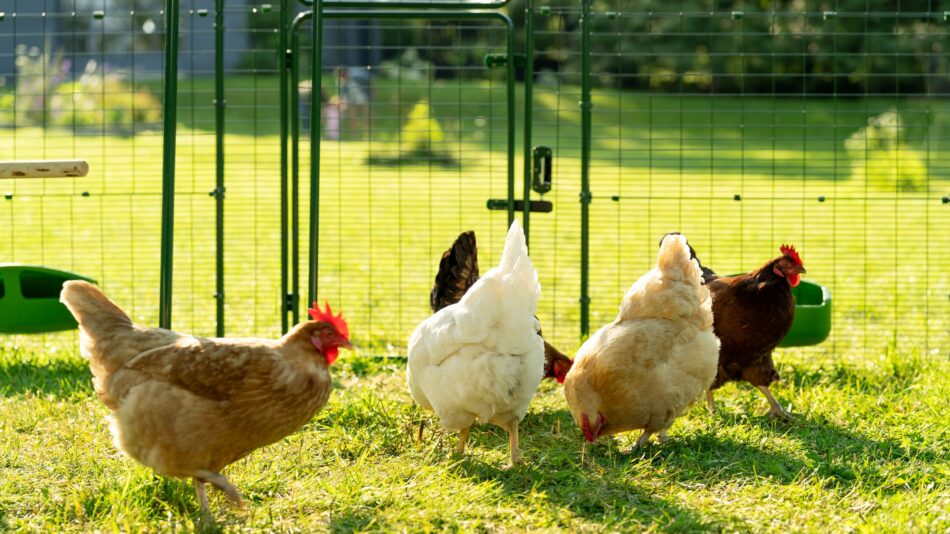

This entry was posted in Chickens
Hey y’all! My name is Alyssa Holland, and I live on a small hobby farm in north-central Texas. We have all kinds of animals on our farm: horses, goats, a miniature pig, rabbits, guinea pigs, dogs, cats, fish, and of course — chickens! We have around 25 chickens currently, and tend a mixed flock of many different breeds. Most recently, we’ve added a rescue pigeon to our flock that thinks she’s a chicken!
It’s late November, and my chicks have officially made the move from brooder to coop! As I mentioned in my previous blog, a lot of thought and consideration went into where to place them, and ultimately I had to rehome 2 of the 6 chicks that I started with. But, it has worked out wonderfully, and I now have a small flock of thriving pullets — and a surprise rooster! See how we made our final transition, and my top tips and tricks to make the move smooth and stress-free.
Before moving chicks
I had to make some important decisions and modifications before moving my chicks. Even though my chicks were old enough to make the move, I had to assess their strength and agility, determine their future flockmates, and rearrange some of their essentials.
Determine physical capability
The most important thing to consider before moving your chicks is if they are fully feathered or not. Chicks that don’t have all of their adult feathers should never be without a heat source. The brooder temperature should be decreasing each week, but chicks with even tiny amounts of fluffy down feathers should not be removed from the brooder. Most breeds are fully feathered by 5 or 6 weeks of age, but I prefer to wait a little longer to make sure they’re mature enough to weather the elements.
For an elevated coop like the Eglu Cube, it’s important to consider your chicks’ physical ability. I actually outfitted the ladder with a homemade ramp, as my Silkies had trouble navigating the rungs. I’ve left it for the chicks, making it easier for them to go up into the coop.
You’ll also want to make sure that your chicks’ feet won’t slip through the roosting rack slats. This is one of the reasons why Omlet recommends waiting until your chicks are 12 weeks old before transitioning them into their coops. I did a “trial placement” of my chicks before officially moving them into their coop to make sure their feet were big enough to be safe on the rack (they were!).
Lastly, make sure your chicks are old enough to grasp the concept of a schedule. They’ll need to be able to put themselves to bed in the roost each night around dusk. You should see them display this behaviour in the brooder as your chicks mature.
Evaluate flockmates
If you have more than one flock like I do, you’ll need to consider the personalities of each hen. Is there a dominant hen that is vigilant in keeping others in line? Is a rooster in the picture? And, is there room for the new chicks in the coop?
My Eglu Cube and Walk In Chicken Run housed a small flock of 2 Polish hens, 1 Bantam Cochin hen, and a Silkie cross hen. The Polish hens are very submissive, while the smaller hens were a mother-daughter duo that had a tendency of ganging up on more timid flockmates.
Ultimately, I ended up moving the Bantam and Silkie cross, leaving just the 2 Polish hens in the Omlet setup. This ensured that my still-young chicks had the most docile flockmates to join up with. Since I rehomed 2 of the chicks, my 6×9 walk in run was the perfect size for this size flock — and I even had room to later add a Barred Plymouth Rock rooster from our other flock that was being bullied by our older rooster. This brought my Omlet flock total to 7 chickens, and they’re thriving!
Change feeder and waterer heights
Omlet’s chicken feeders and waterers are so easy to move up and down on the wire of the walk in run. I made sure to move the waterer and feeder down far enough for my chicks to access them. I feed my chicks medicated chick starter until they are around 12-14 weeks old, so I also hung a separate feeder of their chick feed in the centre of the run, suspended with some thin rope. The run-mounted Omlet feeder holds their layer pellet, which they eat as well.
Making the move
I had taken my chicks for visits around the coop and run throughout their time in the brooder, so they were already familiar with the journey. We made sure to hold them securely, and carry them into the run before gently placing them on the ground. My nephews happened to be visiting us on chick-moving day, so between them, my two kids, and myself, we were able to move all of the chicks in one trip!
Our two Polish hens were absolutely terrified of their new run-mates for several hours — they would stay under the Eglu Cube while my chicks happily explored the Freestanding Chicken Perch! This standoff lasted only until mealtime, where they cautiously observed each other at a closer distance.
Where chicks fall in the pecking order
In my experience, Polish hens have been the most docile and submissive breeds I’ve owned. That’s why I chose to integrate these newcomers in with my two gentle girls. It’s worked out great so far, but every flock needs a top hen (or rooster).
I purposely moved my Bantam and Silkie cross hens out right before moving the chicks in so that the Polish hens wouldn’t vie for the position of top hen between themselves, and in turn bully the chicks. It worked! The chicks moved in, and the older hens went about their usual business, and the drama was kept to a minimum. Typically, chicks will be at the bottom of the pecking order of flocks — at least until they’re old enough to challenge the status quo.
The main issue we ran into was teaching the chicks to go up into the coop at night. They were much more interested in roosting on the Freestanding Chicken Perch for the first few nights — with the Polish hens actually joining them. Once the mature hens started in, I knew we had to break the habit fast! I put all 6 chickens to bed by hand for 3 nights in a row, and closed the coop door. They call caught on quickly, and now head up into the coop at dusk each night with no problem.
A rooster in the roost
Here’s where things get interesting: a Plymouth Rock pullet from our spring crop of chicks ended up being a rooster. Our large flock already has an old, polite rooster, who was none too pleased to have competition in the coop. So, we moved the pullet imposter to the Omlet setup since our other rooster had kept him relatively submissive.
But the plot thickens! The Laced Wyandotte chicks from this autumn were older straight runs. I knew it would be a gamble, but based on feathering and size, I was fairly confident that I had picked out pullets. Alas, now I have matching set of Laced Wyandottes! So, at some point, we will need to rehome one of the roos, but for now, everyone is living in harmony.
Winter preparations
Coming into December, these chicks are now 14-16 weeks old. Since they’re fully feathered and a healthy weight, the winter preparations will be the same as the rest of the flock. Being in Texas, our winters are very mild — until they aren’t! We’re having a typical late-autumn season: slightly rainy, moderate temperatures, with nights occasionally dipping a degree or two below freezing.
I switch from pine pellets to shavings as bedding under the roost rack during the cooler temperatures to add some insulation. I also close the Autodoor on nights when the temperature is freezing or below. This way, by the time winter is in full swing, this small flock will be accustomed to their Autodoor’s schedule.
Once the temperatures are steadily around freezing, we run extension cords to plug in submersible bird bath heaters for the chickens’ waterers. These work great in the Omlet chicken waterers, keeping the water thawed — even in temperatures well below freezing!
We also feed alfalfa hay to our flocks on cold weather days, along with dried black soldier fly larvae and extra scratch grains. They also get a healthy portion of kitchen scraps and chicken-safe leftovers. The chicks are very excited to be expanding their previously limited palettes!
My top takeaways
So, overall, my first experience raising chicks in the autumn was very positive! It wasn’t much different than raising them in the spring — in fact, in our climate, it was even easier. I didn’t have to worry about the chicks overheating in the brooder during warm spring/early summer days. And, preparing chickens for winter in our area is much easier than the scorching summer heat. Here are my top tips and takeaways from this experience:
- I 100% recommend raising chicks in the autumn if you live in the hot southern states. Since chickens fare better in the cold than heat, it’s much easier to transition chicks outside in the more temperate weather.
- Finding chicks during early autumn wasn’t as challenging as I thought, but the selection was more limited than in the spring. Hatcheries still produce chicks throughout the autumn, so next year I may place an order for specific breeds rather than shopping local.
- Move your chicks in with hens that are calm, non-combative, and well-established in their routine to show the younger pullets the ropes.
- We wrapped the bottom 4 feet of our walk in run with hardware cloth. This will keep snakes out, which in our area, are very active in both spring and autumn. Chicks are prime targets for rat snakes in particular, which can infiltrate a run through the top if it’s near a tree or shrub. We keep chicken run covers on the top of the run to prevent drop-ins.
- If you’re like me and miss the longer, warmer days of summer this time of year, chicks are an excellent anecdote! It’s like having a piece of spring with you all autumn and winter long.
And there you have it! I hope you take the plunge next year and try raising chicks in the autumn. It’s been a fun experience that I definitely plan to repeat!
By: Alyssa Holland
This entry was posted in Chickens
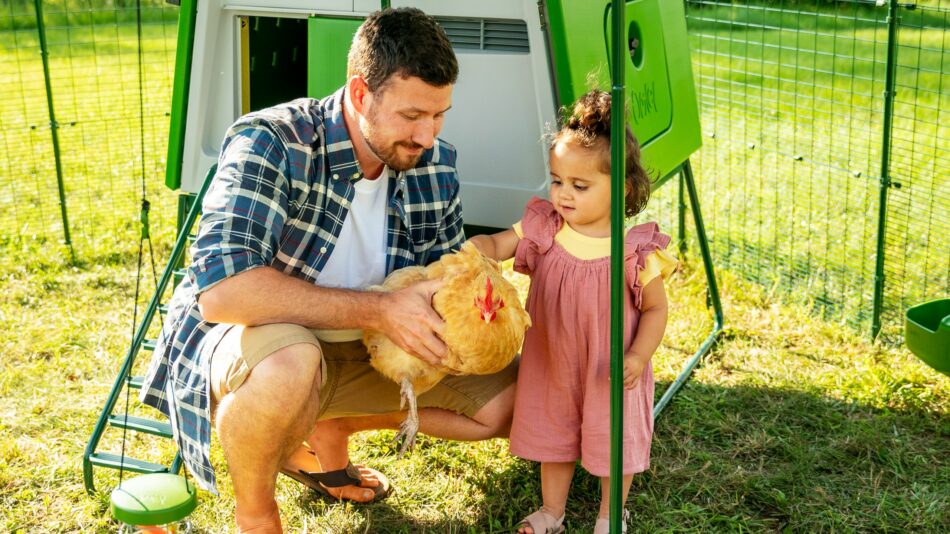
Chickens can bond with their owners, much like other domesticated pets. While holding hens may not be what immediately comes to mind when people envision owning chickens, there are breeds that will tolerate or even enjoy being held by their owners. Chickens aren’t hatched with an innate desire to be handled, but you can take steps to familiarise chickens with the human touch – no matter how old they are. Find out how time, patience, and your setup can help build a deeper bond between you and your flock.
Are chickens affectionate?
As prey animals, chickens aren’t naturally trusting of humans – but that doesn’t mean they can’t be persuaded by your efforts. While some individual chickens may be more outgoing and comfortable around their owners, it’s possible to earn the trust of your other flock members. Patience and consistency are key when gaining the trust of your flock.
The easiest chickens to tame are those that have been handled since they were hatched. Talking to, petting, and handling chicks from a young age will help them understand that you are a friend and not a foe. Physical contact should remain consistent throughout their development to make them as tame as possible as adults.
Chickens that have been rescued can become comfortable with being handled, but you’ll need an abundance of patience. While trust is hard-won, it’s easily lost through mistreatment or neglect. Or, it may be that rescued hens have simply never had any human contact. Whatever the case may be, the steps to familiarise chickens with the human touch are the same for rescued hens as it is for chicks or mature hens.
What about cockerels?
Cockerels are a bit of a wild card when it comes to being handled. Some cockerels are extremely affectionate, while others can be stand-offish or even aggressive toward humans. Since they are at the top of the pecking order in a flock, most cockerels have big personalities one way or the other. Keeping cockerels is a matter of personal preference, but the same methods used for taming hens can be applied to cockerels.
Most affectionate chicken breeds
Just like other pets, each chicken will have their own personality. Some breeds and individual chickens will be more receptive to being petted, held, and handled. Here are the breeds of chickens best known for being the most affectionate toward humans:
Silkies are known as the “lap dogs”, and Orpingtons are known as the “golden retrievers” of chickens. These comparisons to man’s best friends pay homage to the personalities of their breed, but unlike dogs, they still aren’t hardwired to accept human touch. All of these breeds that make the list for being the most affectionate toward humans still need to be won over by their owners – but they’re the most likely to be easily swayed, making them a standout choice for those wanting a flock that can be handled.
3 steps to familiarise chickens with the human touch
Familiarizing your chickens with human touch can be accomplished through time and patience. Depending on your hens’ personalities, age, and background, you can expect being able to handle them effortlessly to come only after a period of training and consistency.
Handle early
If possible, handle your hens from an early age. Newly hatched chicks can be handled with care from the time they’re 2 or 3 days old. If you have older pullets or mature hens, let them settle into their new home over the course of a week or two before introducing the concept of human touch. Establish a routine from the start that your flock can expect. When they’re let out, when they’re fed, and when treats are brought should be highly anticipated events for your hens.
Having a Walk In Chicken Run for your flock makes this process even easier. Stepping into their habitat regularly with positive experiences reinforces trust and affection between you and your chickens. By walking with your flock daily, they’ll start to see you as a normal and enjoyable aspect of their everyday routine and environment.
Beyond the Walk In Chicken Run, you can use Chicken fencing to create a safe perimeter for your flock to enjoy. Our chicken fencing has convenient gates for you to easily enter into your hens’ area to enjoy time with them.
Handle often
Once your hens have accepted you as the giver of food and a regular run visitor, it’s time to incorporate human touch. Start with a chair or stool inside of the run and simply sit with your flock while they go about their business. This new sight might inspire more curious hens to approach you. You can reach out slowly to pet these bolder hens, or sit quietly and let them set the pace.
Keep scratch grains, dried insects or leafy greens with you to reward their curiosity with hand-fed treats. After a few sessions of hand-feeding, move to sit on the ground if possible and encourage your hens to take their treats from your lap. If sitting on the ground isn’t comfortable, move your chair over toward a chicken perch and encourage them to hop onto your lap for their treats.
Repeat this process as often as possible for maximum benefits. Some hens will warm up to you in just a few hours, while others may take several days or weeks. But, once one hen has the courage to make the leap onto your lap, the rest are usually soon to follow.
Handle with care
Once your hens are confidently taking treats from your hand or lap, it’s time to embrace them – literally. Slowly start wrapping an arm around your hens, being sure to encompass both of their wings to prevent them from flapping. Pet them gently and offer more treats by hand. Start out with short holding sessions of no more than a minute or two, working toward longer embraces.
After your hens become used to being held this way, stand up slowly and go for a short walk with them. If your hens object or become nervous, stand still and pet them until they have calmed. Reward their compliance by placing them down near their favourite chicken toys, or another favourite spot in the run.
Your hens are making great strides at this point, but it’s important not to push them too quickly. As the old adage goes: two steps forward, one step back – too much too soon can set your hens back and diminish some of the confidence you’ve helped them build.
What not to do
It may be tempting to rush through the process, or throw in the towel when you don’t think you’re making progress. But, as with many endeavours, success is just around the corner. Be patient with your flock, keeping in mind that as prey animals they can be stressed or startled easily.
When training your chickens to accept human touch, remember:
- Never chase or grab at your hens as they pass you in order to catch them
- Don’t expect too much too soon – every hen progresses at their own pace
- Wait for your hens to complete one milestone before moving on to another
If you let your chickens set the pace, you’ll be delighted to find your bond growing through mutual respect and thoughtful consideration. Remember: your hens are regarding and evaluating you, just as you are them.
Omlet and your flock
Our Walk In Chicken Runs, Chicken Fencing and Chicken Toys and Accessories make building a bond with your flock easy and enjoyable. Foster their natural behaviours and curiosity with our expertly designed products, while making spending time with your chickens effortless. See why chicken keepers who choose Omlet for their flocks’ needs enjoy a more fulfilling experience and deeper relationships with their hens that last a lifetime.
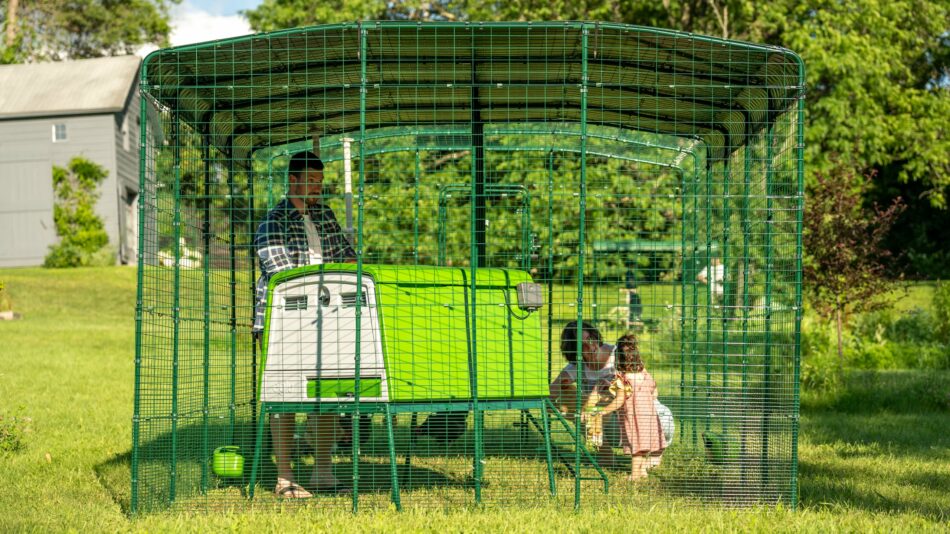

This entry was posted in Chickens
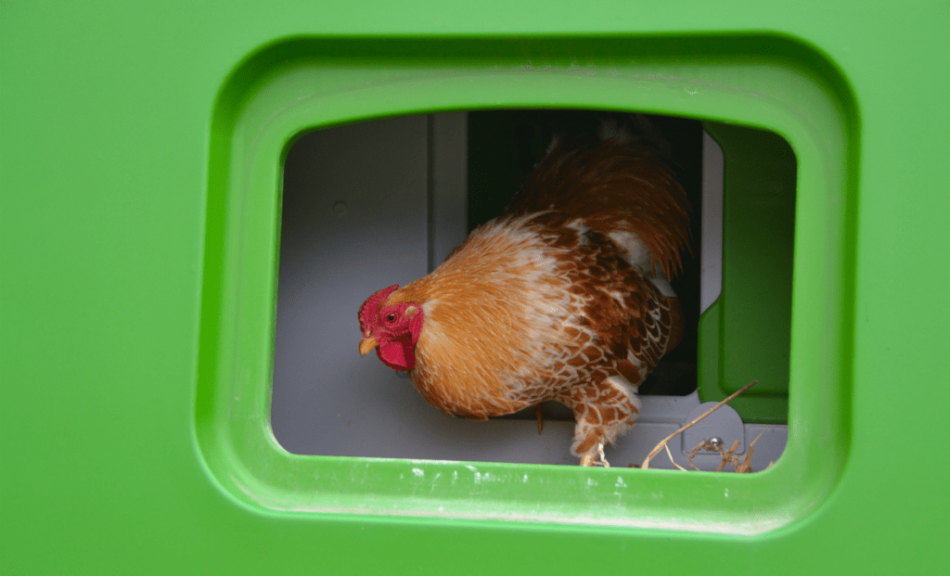
Chicken nesting boxes come in so many shapes, sizes, and materials that it can be hard to decide which type will be best for your flock or coop. Hens need sturdy, safe, and secluded areas to lay their eggs comfortably, and choosing the right nesting box will help achieve this setting. We’ve created the ultimate chicken nesting box guide so that you can maximize your flock’s egg-laying experience while reducing your workload.
What are chicken nesting boxes?
Chickens will instinctively lay their eggs in what they perceive is the safest place to make their nest. Multiple hens will use the same nesting area, trusting the judgement of the first hen who chose the spot. The majority of hens feel most at ease in an elevated station to lay their eggs, but will also seek a dark and secluded area at ground level.
Providing egg-laying hens a comfortable nesting box is an essential role in chicken-keeping. Without a nesting box, hens will become nervous as they prepare for the arrival of an egg, and various negative behaviours or outcomes can sprout as a result of not having a safe nesting area. These include:
- Hens eating their eggs, because they don’t feel like their nest is safe
- Random eggs littered around the run can attract rodents or predators, and encourage flock egg-eating
- Stressed hens with missing feathers, poor appetite, or dull appearance
- A decrease in egg production
Young hens can start laying eggs as early as 16 weeks old, so it’s important that your chicken coop has appropriate nesting boxes from the time you move your pullets in.
Chicken coop nesting box problems
If your flock’s nesting area is not in the right place, or is unable to maintain ideal conditions, your hens will abandon using them. Here are some common problems with nesting boxes.
Placement
One of the main reasons a chicken is not using their nesting box is because of poor placement. Nesting boxes are best utilized when they are part of the coop and not out in the run. They should be in a designated, secluded area where hens neither sleep nor frequent for any other reason than to lay their eggs.
Accessibility
Another key design feature of a nesting box is accessibility – for both you and your chickens. Hens should be able to easily access nesting areas. Nesting boxes should be between 1-3 feet off of the ground, and have a comfortable ramp or ladder leading up to them. The path to the nesting boxes should be kept free of obstructions, and not in an awkward position of the run that has you bending down or squeezing in to collect eggs. If hens can’t easily access their nesting boxes, you’ll find your chicken hiding eggs around the run. It might sound like fun to have an Easter egg hunt every day, but this method of nesting is stressful for hens and can easily lead to unwanted long-term behaviours like egg eating or refusal to use even an accommodating nesting box.
Comfort level
Chickens not laying eggs may be the direct result of them not feeling comfortable in their nesting box. If the nesting box is well placed, and can be accessed easily, but your hens are still not laying their eggs in it, it’s time to consider the comfort of the nesting box. For optimum comfort, make sure your hens’ nesting box:
- Isn’t in a high-traffic area
- Doesn’t receive direct sunlight
- Has low noise levels
- Is well ventilated
- Maintains its cleanliness
Chickens shouldn’t sleep in their nesting boxes, so bedding doesn’t need to be changed as frequently as the rest of the coop. Depending on your bedding of choice and the number of hens you have, the nesting box can be refreshed every 2-4 weeks.
Inappropriate bedding
There are many different choices for bedding in a nesting box, but hens feel best making a nest in loose, fluffy bedding like shavings or straw. Avoid using faux turf pads, kennel liners, or rubber mats in nesting boxes, as these feel unnatural and don’t offer much padding for the eggs being laid. Aspen fibre nesting pads can be fluffed up to make an acceptable nest, and are a good alternative option for chicken keepers wanting to use removable substrate in their nesting boxes.
How many nesting boxes are needed per chicken?
Four hens can happily share one nesting box, but five may become a crowd. Some larger flocks share one nesting box just fine, but it’s largely dependent on your hens’ personalities and laying frequency between chicken breeds. And, any nesting areas need to be large enough for your hens to stand up, turn around, and avoid crushing eggs, while being small enough to feel cosy and secure.
While the term “nesting box” implies a square shape, you can think outside the box when it comes to nesting areas. Oblong nesting areas are a great alternative to traditional boxes, as they give hens more space to fluff their bedding and settle themselves into whatever position is most comfortable for them. Omlet’s chicken coops come in a variety of sizes, all with integrated nesting areas to accommodate any size flock or hen. The Eglu Cube in particular is a favourite among flock-keepers for its elevated structure, dedicated nesting-area door, and sliding partition between the roosting and laying areas. The spacious nesting area allows for 2 hens to lay at time when schedules overlap, and gives your hens options of where to lay their eggs within the space.
There are many different types of chicken nesting boxes. Some are DIY projects, while others are commercially made from metal or other materials. Some are anchored to the coop, while others may pull out or be removed for cleaning. There are pros and cons to each type of construction, but as most chicken keepers would agree, integrated nesting boxes that are easy to access and clean are the best type of nesting areas.
Wooden nesting boxes
Wooden nesting boxes get the job done, but are notorious for harbouring bacteria, mildew, and mites. Because wood is porous, wooden nesting boxes are difficult to keep clean or sanitize thoroughly. They’re relatively inexpensive to make, but can easily be made too heavy to mount to a chicken coop. Because of this, they often require their own support like legs or even a table to be mounted to – something that most backyard flock raisers don’t have room for. Those opting to buy rather than make a wooden nesting box should note that they are usually made from flimsy, cheap materials that will break down quickly.
Pros:
- Inexpensive to construct or obtain
Cons:
- Absorb moisture and bacteria, and house mites
- Heavy, cumbersome, and impractical for most flock raisers
- Commercially made versions are cheap and flimsy
Metal nesting boxes
When thinking about nesting boxes, most people conjure up the image of traditional chicken nesting boxes made of metal. These structures can have anywhere from 1-10+ “holes” that lead into a nesting box. They stack in rows, which takes up less space, but may become too tall for some hens to reach the top row. Metal outlasts wood, but still succumbs to the elements – especially in hot, humid areas. Rust is common in metal nesting boxes, and the boxes themselves can become very hot and stuffy.
Pros:
- Longer lasting than wood
- Easier to clean than wood
Cons:
- Rusts over time
- Can easily become too hot for hens
- Expensive
DIY nesting boxes
This inexpensive option can get the job done, but should only be used for supplemental or temporary nesting areas. DIY nesting boxes can be made from repurposed milk crates, storage bins, or 5-gallon buckets turned on their side. These materials are difficult to place and anchor in ideal locations. They also require alterations to make them safe, which may cost more than the project is worth.
Pros:
- Inexpensive
- Readily available
Cons:
- Flimsy
- Uncomfortable
- Potentially dangerous without modifications
Plastic nesting boxes
The best material for nesting boxes is plastic. This non-porous material is easy to clean and outlasts other types of nesting boxes. It wards also off parasites and prevents moisture buildup. While plastic nesting boxes might not be as popular as other types, their long-term value makes them well worth it.
Pros:
- Long-lasting
- Easy to clean
- Free of parasites
Cons:
- Not as readily available as other options
- More expensive to obtain
The best of both worlds: integrated plastic nesting boxes
Thankfully, there’s an all-in-one option with modern hen houses. Omlet’s plastic chicken coops all have integrated nesting boxes and roosting bars for a convenient and comfortable interior. The nesting area is part of the removable tray, which can be pressure washed and refreshed in minutes.
Creating the ideal chicken nesting box with Omlet
With Omlet, making and maintaining the ideal nesting area is fun and easy. Your hens will feel safe and secure in the elevated and spacious Eglu Cube and its integrated nesting area. This large chicken coop even has a dedicated nesting box door to collect eggs without disturbing the rest of the coop.
With happy hens, you’ll have lots of eggs to gather, giving your family a fresh egg supply. Not only will a clean and tidy nesting box make your hens feel comfortable, but you’ll also have the unique satisfaction that comes from collecting a still-warm egg from the nesting area.
Chicken care with Omlet
Keeping your hens happy isn’t just limited to providing the ideal nesting area. At Omlet, we have chicken-keeping essentials for every area of flock raising. From enriching chicken toys and accessories to technology like automatic chicken coop doors that make your schedule simpler and your flock safer, you can have confidence that your chickens are happy in their coop.


This entry was posted in Chickens
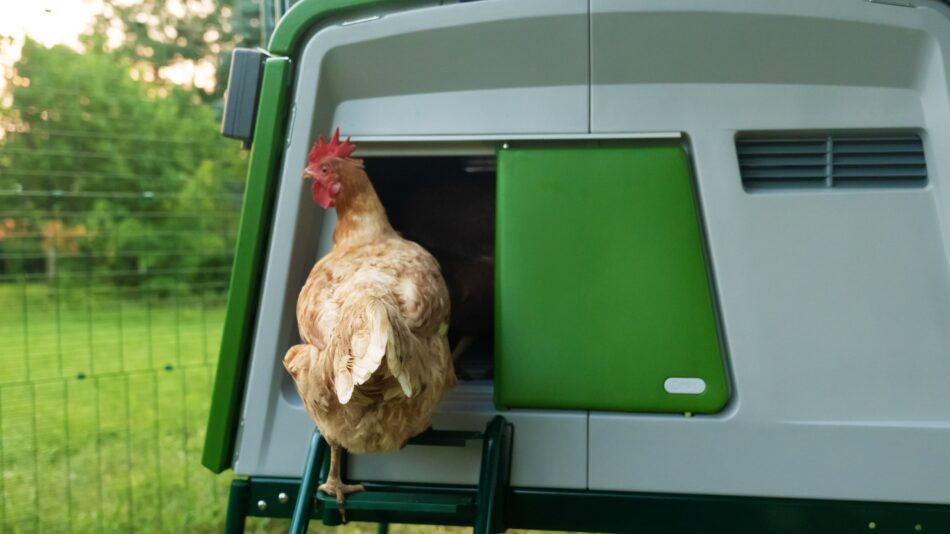
In need of some chicken coop door ideas? Should a chicken coop even have a door? We’ll explore the ins and outs of doors and how they benefit a chicken coop. And, we’ll share how your chicken coop door can act as a sentry against predators, extra insulation in the elements, and even as a babysitter when you aren’t home.
Should a chicken coop have a door?
Your chicken coop should have a door to maintain the safety and comfort of your flock. Chicken coop doors serve two main purposes:
- Protection from predators
- A shield against the elements
Closing the chicken coop door at night is essential to ensure that your hens are as safe as possible against animals that seek to prey on them, and from precipitation or drafts. The ideal time to close your chicken coop door is right after all of your hens have headed off to bed — usually just before nightfall.
The best types of chicken coop doors
There are a few options when it comes to choosing a chicken coop door, and they are largely dependent on the type of chicken coop you have.
Traditional doors
Traditional chicken coop doors are either full-size doors for keepers to walk through, or a smaller version of a wooden door on hinges just large enough for hens to walk through. The problem with these is that wood warps and shifts over time, making them more and more difficult to open and close over time. Gaps along a chicken coop door are dangerous — drafts or predators can slip through any openings that result from shifting or settling doors. Plus, wooden chicken coop doors can’t be attached to just any coop material.
Automatic doors
An automatic chicken coop door is made of easy-to-clean plastic that won’t shift or warp in the elements. It opens the same, smooth way each and every time, and in any weather. Omlet’s Autodoor can be installed on any material: wood, wire, or directly onto the Eglu Cube chicken coop.
In addition to standing the test of time, the Autodoor can be programmed to open and close on a schedule based on the sun or the clock, making it a coop concierge for your flock.
Light-sensing automatic chicken coop doors with Omlet
The Autodoor by Omlet is a sophisticated light-sensing automatic chicken coop door that can be programmed to open and close on a schedule of your choosing. Some standout features of our Autodoor include:
- Light sensor for customized open and close times
- Time setting to set a schedule based on the clock
- Reliability in all weather conditions
- Horizontal opening mechanism for hen safety
- Extra coop security against predators
- Can be installed on any coop or run
- Integrates seamlessly with the Eglu Cube
Chicken keepers love the Autodoor because of its versatility, functionality, and performance. Taking control of your flock’s schedule and having it enforced even while you’re away takes your chicken keeping to a whole new level. The Autodoor’s light setting really shines during the winter months — your hens can be closed in before the sun is finished setting, and stay warm and comfortable in their coop until there is plenty of sunshine the following morning. You and your hens can both sleep in during the coldest hours of the morning, knowing the Autodoor has made winter chicken keeping easier than ever.
Easy steps to install a chicken coop door
The Autodoor is easy to install on any existing setup. Just choose the fixings pack that corresponds to your coop when you purchase your Autodoor, and you’ll have everything you need for installation when it arrives. Choose from wood or wire for your fixings pack, and follow the detailed instructions for installing your Autodoor. If you have an Eglu Cube chicken coop, no additional fixings need to be purchased — you can install the Autodoor right out of the box.
Once installed, the control pad makes programming your schedule quick and easy. If you choose to use the light setting, the amount of daylight can be selected on the Autodoor for both open and close times, and custom delay open and close times can be adjusted. This would give your hens a buffer for the weather to warm up, or for storms to clear if the light sensor hasn’t been able to receive its programmed amount of light.
Should I make a chicken coop door?
Making a chicken coop door is an option, but significant attention to detail and considerations need to be taken into account. Chickens have fragile legs that can be caught easily in doors, and materials like wood will rot and warp over time, making a path for crafts or predators to penetrate the coop. You’ll also need to manually open, close, and secure your DIY chicken coop door each day to ensure safety, which means trudging out in harsh weather or going out in the dark when you’re home late.
Choosing an Autodoor is a one-step solution to your flock’s security and comfort. You won’t worry about safety or functionality, and with the added ability to automate your flock’s schedule, you can rest assured that your hens are being cared for — while you enjoy the comfort of your own bed.
Pet care with Omlet
Omlet makes keeping your hens easy and enjoyable. We take the guesswork out of caring for your flock, because we’ve asked both the obvious and the unexpected questions when it comes to creating the ideal chicken setup. Our chicken runs, chicken tractors, and hen houses are all designed to accommodate both you and your flock for an unparalleled chicken-keeping experience.
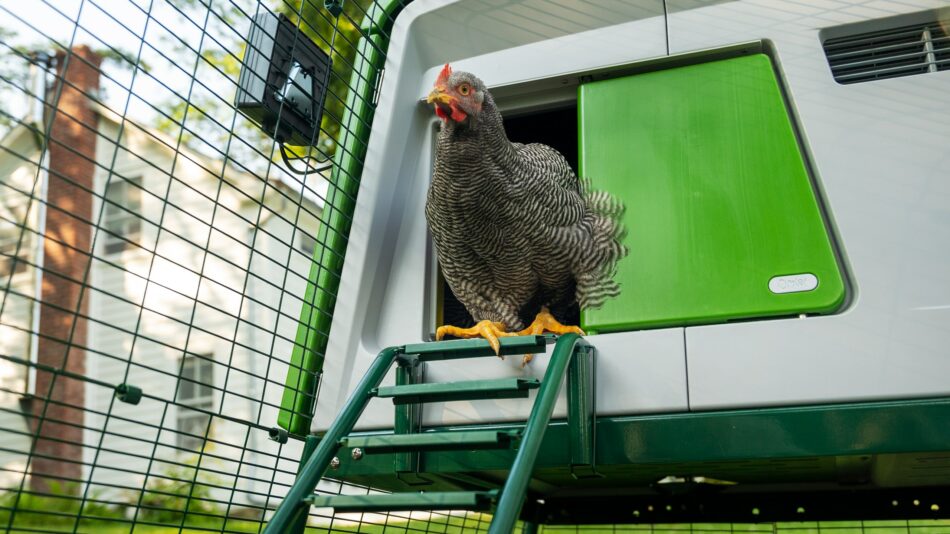

This entry was posted in Chickens
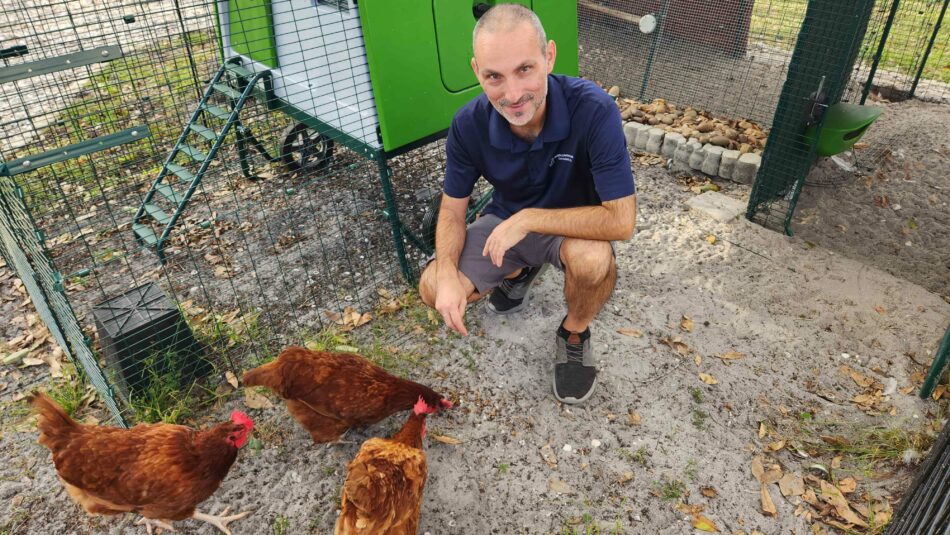
Jeremy Gary lives in Venice, Florida. He’s a husband, father to 2 boys, proud chicken owner, and an Omlet Ambassador. Most of his chicken-keeping knowledge came through trial and error, as well as seeking advice from experienced local chicken keepers. Long before becoming an Omlet Ambassador, Gary purchased his first Omlet product. It was an Eglu Cube. And its design transformed the experience of keeping chickens for his family. In Gary’s professional life, he owns and operates a building science consulting business. Knowledge of temperature and moisture dynamics in the hot, humid Florida climate has proven very helpful in keeping chickens. In Gary’s spare time, he enjoys spending time with his family doing outdoor activities – his favourite of which is paddleboarding over to the beach for a few hours before sunset.
As chicken owners, we all want the best for our feathered friends. With a little time and some trial and error, we settle into a routine of chicken care that works for our flock. Everything is going great. The chickens are happy and healthy, and we feel like we really understand the needs of our flock. And then one day, feathers suddenly appear on the ground. At first, there are one or two here and there. And then, a whole bunch of them start to appear. What’s going on? Don’t worry, this is a natural process that all chickens go through called moulting. Moulting is the natural process of feather replacement in chickens. With a little extra care and attention, we can help our feathered friends through the moulting process. Omlet has some thoughtfully designed products that can help promote a clean, safe, and comfortable environment which is critical during this period.
How to spot moulting
Let’s talk a little bit about what chicken moulting is and how to recognize it. Moulting is a normal and beneficial process for chickens that helps them renew their feathers and prepare for the changing of the season. Chickens shed their old feathers and grow new ones. It’s a natural and necessary cycle that helps chickens to maintain both their health and appearance. Feathers are important for chickens because they provide insulation and protection. The moulting process allows chickens to replace damaged, worn out, or dirty feathers with fresh, clean, and strong new feathers. Molting usually occurs once a year, but it can vary depending on the breed, age, and environment of the chicken.
All animals go through some type of change as summer gives way to fall in preparation for the change of seasons. Dogs, for example, may shed a summer coat in favour of a winter coat. Wild birds in the northern hemisphere will fly south for the winter. Other animals simply hibernate to wait out the winter until spring returns. For chickens, the seasonal transition often involves the process of moulting. Understanding what moulting is and why it occurs is important for all chicken owners. Once we understand that it is both normal and natural, we can best help support our flock throughout the process.
The 3 phases of molting
Moulting can take anywhere from a few weeks to a few months, depending on the individual chicken. During the moulting process, a chicken’s behaviour can change significantly. For example, a chicken may stop laying eggs, reduce their overall activity, or lose their appetite. It isn’t uncommon for chickens to be irritable during molting, or maybe even a little socially reluctant. They may choose to spend more time by themselves away from the rest of the flock. Every chicken will react just a bit differently to the moulting process. Just remember that this is a normal, natural occurrence in their lives. But nonetheless, it’s a stressful time for them.
There are 3 basic phases of moulting: the pre-moulting phase, the moulting phase, and the post-moulting phase.
Phase one
The first phase is the pre-molting phase. Think of this as the resting period before moulting begins. This is where you may notice behavioural changes, such as reduced activity, a smaller appetite, and an end to egg-laying. The purpose of the pre-moulting stage is to conserve energy and to prepare for feather replacement. Shedding and replacing feathers requires lots of energy! This pre-molting phase can last anywhere from a few days to a few weeks.
Phase two
The second phase is the actual moulting phase. This is the time when a chicken will begin to lose its feathers. Feather loss will typically occur in a pattern, beginning at the head and neck and then working back toward the tail. During this time, a chicken may look bare and patchy. Throughout the moulting process, chickens are often more irritable and may shy away from other birds. Seeing this significant change in behaviour can be very stressful to a chicken owner if you don’t understand exactly what is causing it and why it is occurring.
Phase three
The third and final phase of the moulting process is the post-moulting phase, or the regrowth phase. New feathers will start to grow in from follicles where the old feathers fell out. The new feathers are often referred to as pin feathers and can look like little thin spikes with a waxy coating. New-growth feathers are sensitive and can be easily damaged. You may notice that your chicken is preening more than usual as they work to remove the wax coating and fluff up their new feathers. After a few weeks, the new feather growth will be complete, and your chicken will regain its normal appearance. Physical activity and social interaction with the flock return to normal, as will egg laying.
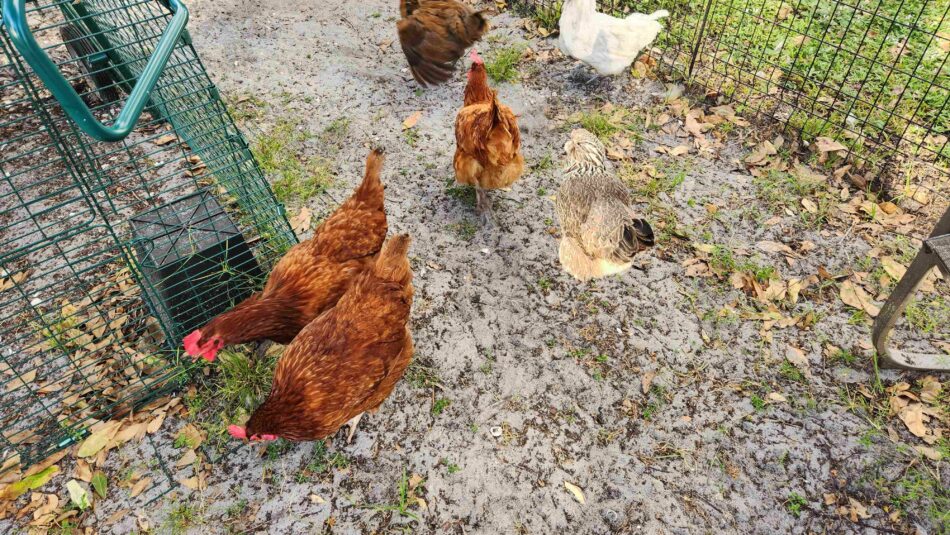
Helping your hens through their moult
During the moulting process, proper nutrition is essential to helping your chickens to grow healthy, new feathers. Replacing feathers is a high-energy activity! A diet with lots of protein is key. A feed with high-protein content can be helpful. Many chicken owners will substitute additional protein during the moulting period in the form of high-protein treats. Mealworms and soldier fly larvae are excellent sources of protein that your flock will love. Always make sure your flock has access to clean, fresh drinking water. This is important every day, but especially during moulting.
While chickens are going through the moulting process, there are a few simple things that chicken owners can do to help them through this stressful time.
- Avoid disturbing chickens unnecessarily during the moulting period. Moulting can make chickens more sensitive and irritable than normal. Handle your chickens gently during this time. And be extra patient and understanding if they want a little alone time.
- Keep your chickens safe and comfortable. Molting can make chickens more vulnerable to heat, cold, rain and snow, as well as to predators. Adequate shelter and protection from the elements and potential threats can be a big help.
- A high-protein diet to support feather growth is essential. You can supplement their feed with treats such as mealworms, soldier fly larvae or sunflower seeds.
- Clean, fresh water is essential for hydration during moulting. And a clean coop will prevent parasites and infections, which can worsen moulting or cause infections during this vulnerable time.
Omlet and your flock’s molt
And here is where the Omlet family of products can play a vital role in supporting your flock during the moulting process by providing safety and comfort. The unique construction of the Omlet Eglu Cube Chicken Coop lends itself to clean coop keeping, with its unique and easy-to-clean plastic design. The durable construction keeps chickens safe from predators during the vulnerable moulting period. And finally, comfort. The Eglu Cube is designed with chicken comfort in mind – everything from ventilation to superior insulation.
Moulting in your area
Depending on where you live, the needs of your chickens during the moulting period may be different. For example, if you live in an environment that may have cold temperatures during the moulting period, you may want to provide a little extra warmth to help with some of the exposed areas of the chicken’s body.
We live in SW Florida, so cold isn’t a problem in the fall. In fact, it is the opposite – heat and humidity can still be an issue. Even in October! We have a very hot and humid summer that seems to last forever. Moulting will often begin just as the stress of making it through a long summer is winding down for the chickens. To help them through, we always provide plenty of shade and icy treats. Things like ice cubes in their water or frozen watermelon to snack on. For protein-rich snacks, our flock loves soldier fly larvae.
By understanding what the moulting process is, you can provide great care and support for your flock to help them through this stressful time. By providing your flock with a few key things like a protein-rich diet and a safe, clean, and comfortable shelter, your chickens will emerge from the moulting process with a brand-new set of feathers to last them all year long. Oh, I almost forgot to mention the most important thing of all to help your flock through moulting – an extra-large portion of chicken-owner love!
Omlet has a great line of products that can serve your flock during the moulting process but throughout the entire chicken-raising process. They have truly unique and well-designed products that have transformed our chicken-keeping experience. Before becoming an Omlet Ambassador, I was the proud owner of several of their products. I encourage you to reach out to Omlet to learn more about how their family of products can help transform your chicken-keeping experience as it did for our family.
Our Eglu Cube even survived a Category 4 hurricane. But that’s a story for another blog post.
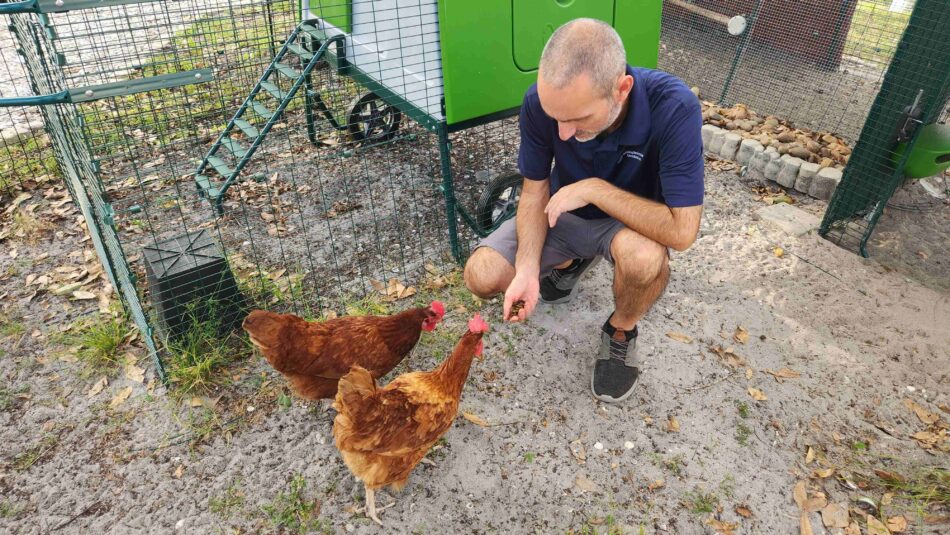

This entry was posted in Chickens
Hey y’all! My name is Alyssa Holland, and I live on a small hobby farm in north-central Texas. We have all kinds of animals on our farm: horses, goats, a miniature pig, rabbits, guinea pigs, dogs, cats, fish, and of course — chickens! We have around 25 chickens currently, and tend a mixed flock of many different breeds. Most recently, we’ve added a rescue pigeon to our flock that thinks she’s a chicken!

Welcome back to my autumn flock-raising adventure! My group of six chicks are thriving in the cool(ish) temperatures, and they’re growing like weeds. Their personalities are starting to shine, and preparations for their future accommodations are being made. See what we’ve been up to, and what I’m expecting throughout the rest of the season.
How they’re growing
Y’all, chicks grow fast! And, since I started with older chicks, time has flown. Both breeds were fully feathered around 6 weeks old and are growing at the same rate — which has made brooding them together a breeze!
The chicks are around 7-8 weeks old now. The Silver Laced Wyandottes are beginning to show their gorgeous colouring, and the barred pattern of the Plymouth Rocks are on full display. I removed their brooder plate last week once they were fully feathered. I usually keep a heat source in with my chicks until they are closer to 8 weeks old, but since the weather is still very warm during the day (high 80s to mid 90s°F) and has not been dipping below 75 degrees°F at night, I went ahead and removed their heat.
We hopefully have all pullets from this batch! I rolled the dice a bit by getting the Silver Laced Wyandottes — they were straight runs that had outgrown their pen. Our Tractor Supply store was kind enough to let me hand pick my own chicks, so I compared feathers and combs and selected what I hoped were 3 females, but only time will tell. The Plymouth Rocks were pullets, but earlier this year I purchased two Plymouth Rock pullets, and we now have a beautiful Plymouth Rock rooster! It was a good reminder that unless a breed is a sex link (can be sexed at the time of hatching by feather patterns or colour), mistakes can happen. Thankfully, our property isn’t subject to animal restrictions, so we are able to keep roosters, so long as they live peaceably with the rest of the flock (and don’t chase my children!).
Future flockmates
Normally I don’t count my chickens — before or after they hatch! Chicken math gets me every time. So instead of counting my birds and measuring the square footage of our coops and runs, I measure our “chicken saturation” by their health and happiness. If everyone is thriving, it’s a stable and sustainable flock!
We have two setups: one is a very large chicken coop and run that my husband built shortly after we moved in over 5 years ago, and the other is an Omlet Eglu Cube with an attached 6×9 ft Omlet walk in chicken run. Our homemade setup houses around 18 hens and 2 roosters, with another 4 hens and 1 rooster calling the Eglu Cube home. The chicks I’m currently raising will be placed in the flock that best matches their personalities, with some consideration given to space requirements. I try to keep my smaller or more docile hens in the Eglu Cube setup partly because of the size, but also because it’s easier for my kids to access both the eggs and the run to play with their favourite hens! We try not to play favourites, but every flock inevitably has favourites that steal the hearts of their keepers.
It’s hard to determine where chicks will fall in the pecking order, but usually, newly introduced chicks will be toward the bottom of the hierarchy. Since my chickens are kept in runs, I have fellow flock-raising friends that free-range on standby to accept any birds that don’t fit in with my flocks. It’s a rare occurrence, but occasionally a dominant hen or a very low-ranking hen has to be rehomed to a friend to maintain the peace. So, there’s a possibility that one or more of my older hens (or these new chicks), will find their homes on another farm. It’s a win for my friends and a win for the hens — we’re always looking out for the best interest of our flocks!
Establishing a schedule
Chickens thrive on schedules – starting at a young age. Because my chicks are in an outdoor pen, they’re able to follow the natural schedule set by the sun. And, with our other setups within their line of sight, they can take their cue to head to bed from their future flockmates.
Schedules and routines are also helpful when it comes time to handle your chickens. From performing health checks, to just wanting to spend some quality time together – you’ll need to be able to catch your chicks at some point. Schedules are also important to your growing flock’s safety. For example, our miniature pig let herself into our chicks’ pen and they went on a happy excursion through our wisteria vine-covered terrain. But, because they knew their schedule, they headed in to roost when it was time, effectively saving me the trouble of having to chase them down. We decided to let them have their (supervised) free-ranging experience, but even at their young age they were able to put themselves to bed when it was time.
If possible, I highly recommend brooding your chicks in an area that receives natural light. This is another reason why I love using a brooder plate over a heat lamp. Not only do brooder plates carry a lower risk of causing a fire, they don’t emit any light. If your chicks are able to sleep and rise along with natural patterns from early on, it makes the transition to their forever home much easier for everyone!
Activities at this age
Chicks around 8 weeks old are beginning to resemble miniature versions of their full-grown selves, rather than fluffy hatchlings or patchy youngsters. Their colours and patterns are more vibrant, and you can sometimes start to see characteristics of roosters versus hens at this age. And, because they’re bigger and more coordinated, you’ll start to see them display their personalities and desire to play and explore.
I’ve adjusted the angle of their tree limbs and makeshift perch to accommodate their growth and skill level. My son also helped me hang a “chick swing” from the front of their run. And, while it should be noted that it’s not recommended to offer anything other than their chick feed at this age, I’ve started giving small tastes of dried mealworms and dried herbs as treats by hand to my chicks. This gets them used to me being the “treat lady”, and now I can easily get their attention when I shake the treat bag!
Another favourite activity at this age is scratching and dust bathing. They’ve made their own dust bath at the end of their enclosure, but I added some dried oregano to the area for extra incentive. I also give them coastal hay to scratch around in, which is a favourite afternoon activity! Hiding some of their herbs and mealworms in the hay keeps their minds and bodies occupied while I clean their brooder.
I also added a favourite activity of my own to their area: a spot to read! By hanging a hammock across from their enclosure, I can enjoy watching my chicks play and forage and take advantage of the cooler weather. Plus, the central location lets me see my other flocks, so everyone is used to seeing their caretaker curled up with a good book!
What’s next
In the weeks ahead, my chicks will be moved to their permanent homes. As they continue to mature, their genders will be apparent, which will play a large role in how they are placed. Their growing appetites will call for laying feed soon, and we will start introducing them to scratch grains and other protein-packed treats to help them gain weight and maintain healthy plumage throughout the cooler months.
By: Alyssa Holland

This entry was posted in Chickens
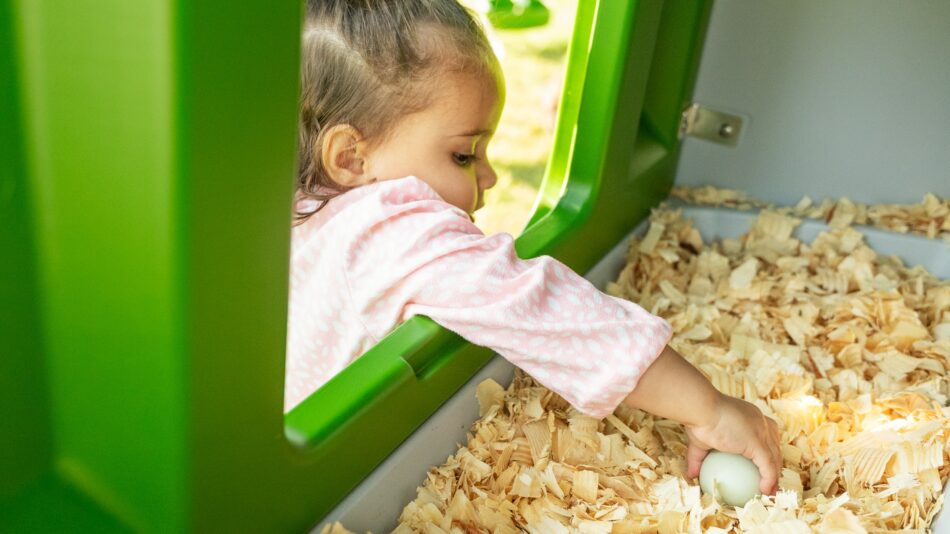
Eggs are amazing, nutritious feats of nature that chickens give back to their keepers. They come in a variety of sizes, colours, and sometimes even shapes, but sometimes their appearance can surprise those who come to collect them. From the normal to the not-so-normal, we’ll cover it all in our What are your hens’ eggs telling you? guide.
Why are chicken eggs sometimes misshapen?
An oddly shaped egg can be produced for various reasons. It often takes young hens an egg or two before they settle into their regular pattern. Stress in the chicken coop can lead to misshapen eggs too. This is usually due to a hen having the urge to lay but finding the space in the laying box occupied by another bird.
Misshapen eggs can be:
- Elongated, or they may have a thin, pointy end.
- Rough with bumps
- Thicker around the middle, appearing in a band pattern
- Round rather than the traditional oblong appearance
A ball-shaped egg is usually a sign of slight calcium deficiency. The round shape requires less calcium than a normal oval egg. In all these cases, the egg inside is unaffected and is perfectly safe to eat.
Infectious bronchitis can lead to misshapen eggs. An infected hen will stop producing eggs for a few days or will only lay intermittently. The eggs that are laid will have thin, wrinkled or rough shells, and the white of the egg will be watery. It is also common for the affected eggs to have lighter-coloured shells than usual. This condition is uncommon, and should be diagnosed by a veterinarian.
Laryngotracheitis is another illness linked to egg abnormalities, but should also be diagnosed by a veterinarian. It’s important to note that any ailment can cause a hen to become stressed, which can cause a hen to lay misshapen eggs.
Why do chickens lay freckled eggs?
Some breeds always lay speckled eggs. However, if a hen that typically produces plain eggs lays speckled ones, there are various possible causes. She may have been stressed in some way while the egg was forming, or she may have developed an anomaly in the pigment-producing part of her egg-laying system.
Freckling is often the result of excess calcium production, sometimes associated with the ‘end of season’ laying at the beginning of winter. On some eggs, there is a marbled pattern rather than an area of freckles.
The speckling is usually smooth, but it sometimes manifests as raised blotches of excess calcium. These can be spots or wormlike strands, and they often occur as single spots on an otherwise standard egg. This may be linked to dehydration, so make sure your hens have enough water, and that a timid hen isn’t being bullied out of being properly hydrated.
Why do chicken eggshells sometimes have a white ring?
Viewed from the side, an eggshell with this peculiar oddity has a thick white ring, looking like an x-ray of the egg that lies beneath. It is usually caused by an interruption in the formation of the eggshell, caused by stress or by a second egg entering the internal production line.
The second egg produced in this process will usually have a flattened side, as it has bumped into the first egg during the early stages of shell formation and has been ‘squashed’ into an odd, flattened shape.
Why are chicken eggs sometimes wrinkled?
An eggshell with wrinkles can be a sign of stress or illness, but is usually a hereditary condition. Some older hens begin to lay wrinkled eggs too. The wrinkles are often deep grooves, giving the appearance of a very misshapen egg that is perhaps the most unusual of all egg oddities.
The wrinkles sometimes look like a series of cracks in the shell. This results from an egg cracking during calcium formation. The cracks are the chicken’s repairs – laying calcium over the fissures. Once again, the underlying cause is usually stress or illness, although sometimes it is simply the result of a second egg ‘crashing into’ the first due to an over-productive system.
Why do some eggs have double yolks?
In a rare, but completely normal phenomenon, chickens can lay eggs with two yolks inside. If fertilized and incubated or kept under a broody hen, double-yolked eggs can hatch twin chicks – but it’s more common for only one embryo to fully develop.
If you crack one of your chickens’ eggs and see two yolks, it’s the result of the hen releasing two yolks at the same time during ovulation, which then becomes encapsulated within one shell. It’s more common for newly-matured hens to lay double-yolked eggs, as their bodies are adjusting to ovulation. Laying eggs with two yolks can also be genetic, and the hen may continue to do so for the duration of her egg-laying career.
You do not need to crack the shell to find out what is inside – you can spot a double-yolker by ‘candling’ the egg. The word candling comes from the ancient practice of holding an egg in front of a candle flame, but a small flashlight does the job just as well. If there are two yolks inside, they will be visible as two dark blobs against the bright light as it shines through the shell.
Although double-yolkers are estimated to occur in just one per thousand eggs, the huge population of laying hens over the world means that they are a common sight on the plates of chicken keepers. Triple yolks are possible, but are very unlikely to grace the breakfast table– this ultra-rare phenomenon is found in just one per 25 million eggs.
Why do chickens lay less eggs sometimes?
Breed, age, health, and time of year all affect how many eggs chickens lay. Among the many different chicken breeds that are considered good layers (those that can lay upwards of 300 eggs per year), some well-known egg producers include:
In contrast, most ornamental and smaller chicken breeds lay less frequently, with some only laying a few eggs each month.
Depending on their genetics, hens will begin to ovulate (release a yolk) every 24 hours on average, starting at 6 months of age. Once a yolk has been released, it takes 19-20 hours to finish forming and be fully dressed in an eggshell. After an egg has been laid, the process repeats again – good layers can begin ovulating again within an hour after laying an egg. A hen will lay the most eggs during the first two years of life. After that, production begins to decrease by 10-20% each year.
Hens that are not feeling well, or are malnourished will lay less frequently. Flock discord, inadequate nutrition, and overcrowding are a handful of stressors that can take a toll on egg production. Make sure your hens have access to clean water and quality layer pellets at all times to ensure they’re getting the calories and nourishment they need. Adding scratch grains, chicken treats, and healthy kitchen scraps or safe foods from the garden to their diet will also give hens a nutritional boost.
Hens will inevitably lay less, or stop laying eggs altogether in the winter. A hen’s ovulation cycle is based on daylight hours, so once the days shorten, you can expect egg production to slow down. This is a hen’s natural reaction to the changing seasons as they prepare to reallocate energy to keep warm instead of laying eggs. Your hens will resume a normal laying schedule closer to spring, as days grow longer.
Another annual reason for a decrease in egg production is moulting. Moulting is the process of shedding old feathers and regrowing new ones to replace them. Moulting also occurs during the fall in preparation for winter – so as the days grow shorter, your hens will begin to lose their dingy feathers in favour of new, denser ones to keep them warm. The result is a beautiful, vibrant new feathery outfit for your hens – but fewer eggs for you to gather. Moulting takes a lot of energy, so expect your chickens to be on “lay-cation” for 8-16 weeks. There are some things you can do to help your chickens through a molt to offer relief during your flock’s annual feather renewal.
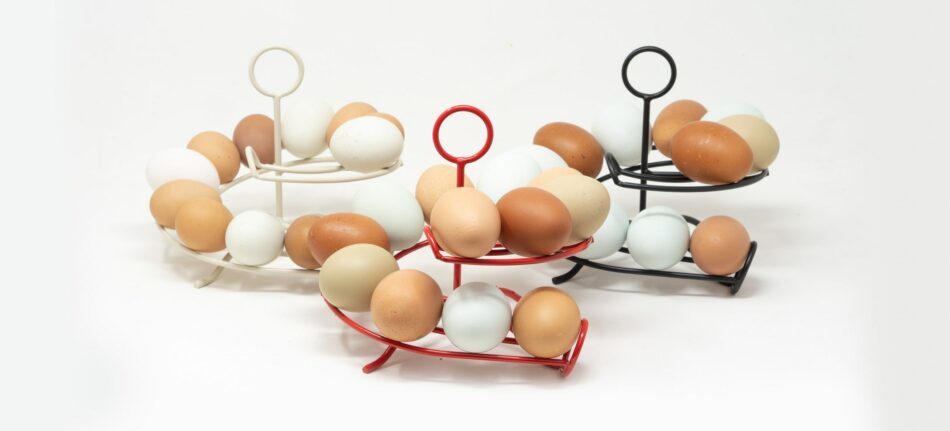
Why do chicken breeds lay different-coloured eggs?
You’ve probably seen white and brown eggs, but some chickens can lay eggs in shades of green, blue, and even pink. But what causes such a variety of colours?
Genetics determine what colour eggs a hen will lay. Some breeds of chickens have a standard colour you can expect from them. For example, you can count on Leghorns to lay white eggs, Orpingtons to lay brown eggs, and Ameraucanas to lay blue ones. But different shades such as olive are the result of a hybrid hen – a hen bred from a combination of blue and brown egg genes. For example, if you breed an Orpington (brown egg genetics) cockerel with an Ameraucana (blue egg genetics) hen, the result would be an “olive egger” hen that would lay green eggs. Egg colour should be consistent with the hen laying them, and different-coloured eggs are not a cause for concern unless a hen suddenly starts laying a different shade from usual.
All eggs begin with a white shell, but the hen laying the egg adds a pigment to them as they make their way to be laid. This pigment only colours the shell, and does not penetrate the membrane. You’ll have to add food colouring if you want green eggs and ham!
Other breeds known for laying colourful eggs include: Rhode Island Reds, Plymouth Rocks, Wellsummers, and Marans. Hybrids (bred through selective pairing), such as Olive or Easter Eggers, can produce eggs varying in colour based on their genetics.
Pro tip: you can get an idea of the colour eggs a hen lays by looking at their earlobes. Hens with white earlobes will lay white eggs, and hens with red earlobes will lay brown eggs. This technique is not as accurate for pigmented eggs (blue, green or pink), as hybrid chickens will have a variety of colours to their earlobes. Still, it’s fun to try this prediction test with your flock.
Why do my chickens’ eggs have a thin shell, or no shell at all?
Have you ever collected eggs, only to find yourself flabbergasted by a naked egg? Thin-shelled eggs or those with no shell at all feel like partially filled water balloons and can be very disconcerting to find in the nesting box. These strange, spongy eggs are actually laid without the presence of the shell; only the membrane. This most often occurs with high-producing hens, when their bodies simply cannot keep up with yolk production. Oftentimes they will lay a fully-formed egg, then lay a shell-less egg a few hours later.
The other most common reason for eggs having thin or missing shells is inadequate calcium in their diet. Warning signs leading up to shell-less eggs can be thinner shells, so take note if your hens’ eggs are suddenly much easier to crack, or if you find broken eggs in the nesting box. A lot of calcium is required to “fully clothe” a yolk, so be sure to feed quality layer pellets that contain added calcium. If you notice thinner shells or “naked” eggs, supplement your hens’ feed with crushed oyster shells or other chicken calcium supplements. You can also save egg shells after cracking them to crush or grind up and sprinkle on top of your hens’ feed. Be sure not to offer shells that have not been broken down into smaller pieces, as chickens can acquire a taste for eggs and can actually eat them straight out of the nesting box.
Boost your hens’ shell-producing ability with chicken supplements to ensure they have all of the vitamins and minerals they need. As an added bonus, supplements such as omega-3 fed to your chickens are passed onto their eggs– and then to you when you eat them!
Why do chickens sometimes eat their eggs?
Hens will actually eat their own eggs, usually for specific reasons. This behaviour can usually be corrected when adjustments are made to their environment.
Dehydration
Chickens that eat their eggs may be dehydrated. Since eggs contain a large amount of water, your chickens may be resorting to eating them in an effort to keep themselves hydrated. To stop egg eating due to dehydration, make sure that your hens are supplied with clean water at all times.
Vitamin deficiency
Your chicken’s diet is fundamental to their well-being, and a poor one could be depriving them of their nutritional requirements – leading them to feast on their eggs in an effort to recoup missing nutrients. It’s important to provide your chickens with a balanced diet of enough protein, carbohydrates, vitamins, and minerals. For added calcium, offer crushed oyster shells.
Issues with the nesting box
Your nesting box needs to be a secure and safe space for your hens. Egg eating can occur when your hens are uncomfortable with the nesting box, most commonly due to the bedding itself or exposing your chickens to too much light. Make sure that their nesting area:
- Has adequate bedding made of a comfortable nesting material
- Remains free of droppings or debris
- Does not receive direct sunlight
- Has enough space for the number of hens you keep
- Is completely separate from the roosting area
Our chicken coops are designed for easy cleaning, and with integrated and private nesting boxes, while leaving plenty of space for roosting. This ensures a comfortable and hygienic habitat for your hens that will support them in their laying efforts.
Behavioural
Chickens found to be eating eggs can also be suffering from stress or anxiety, which hens can experience for a number of reasons. Stress-inducing scenarios can be related to:
- Being handled
- A new environment
- The introduction of new chickens
- Extreme heat
- Visits from predators
Some stressful situations are easier to alleviate than others, such as introducing new chickens or excessive handling.
Chickens that eat eggs may simply be bored. Boredom in chickens can occur when they don’t have enough space to roam, or they lack activities to keep them entertained.
For a happy hen, provide as much space as possible outside of the coop with a walk in chicken run or chicken fencing. Chicken toys are another great way to keep your chickens entertained.
Omlet and your hens’ eggs
The more love and care you put into your flock’s setup and your interactions with them, the happier and healthier your hens will be – and the more delicious and healthy their eggs will be. Hens that are kept in clean, safe chicken coops will lay eggs more regularly and without difficulty. The joy and companionship you’ll reap from sowing a great relationship with your hens will accompany the steady supply of eggs for you to display in your kitchen – a visual reminder of the bond you share with your flock.
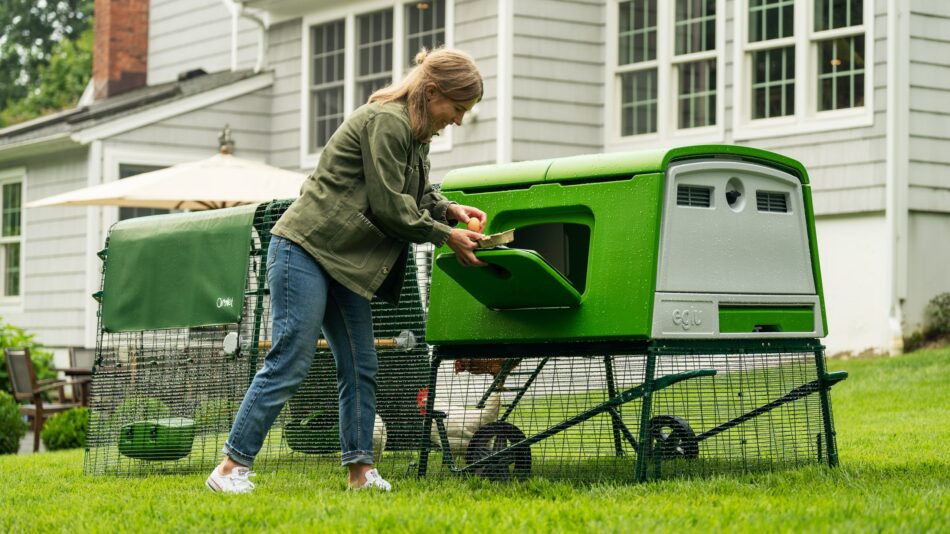

This entry was posted in Chickens














































